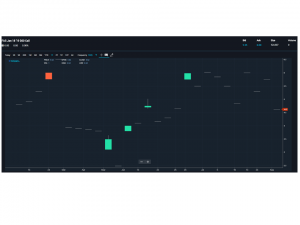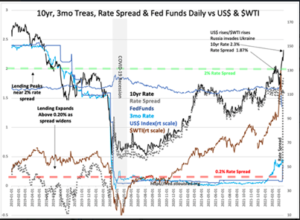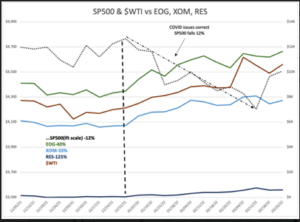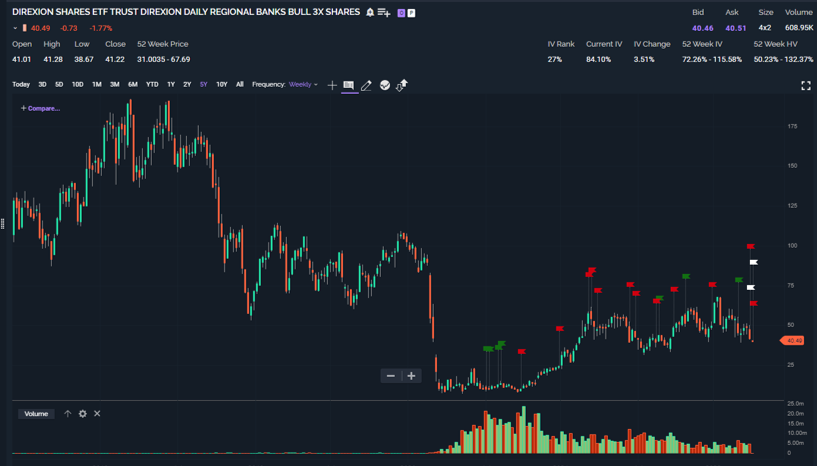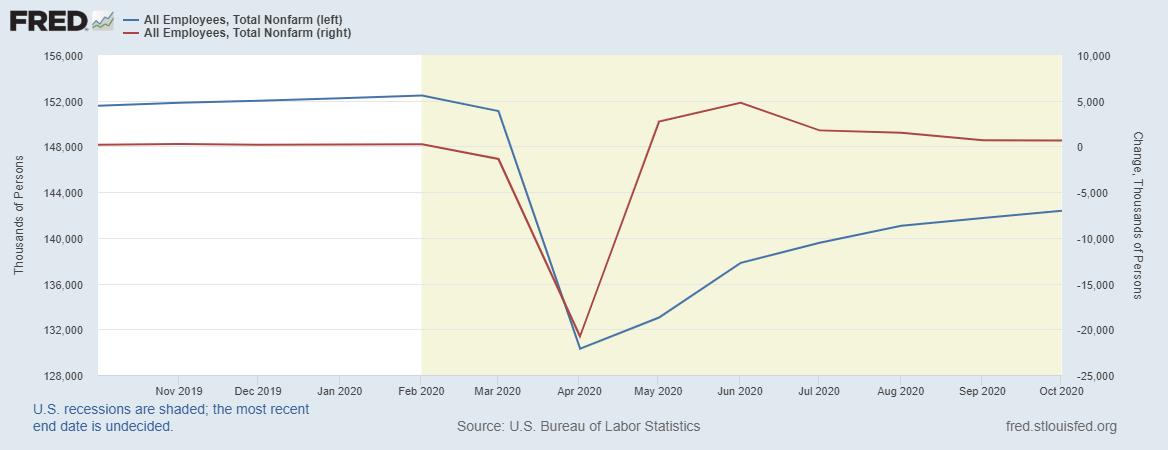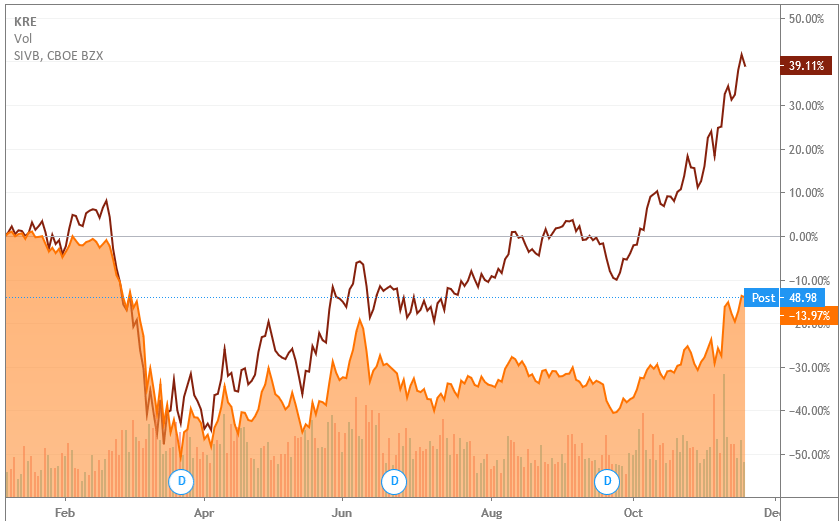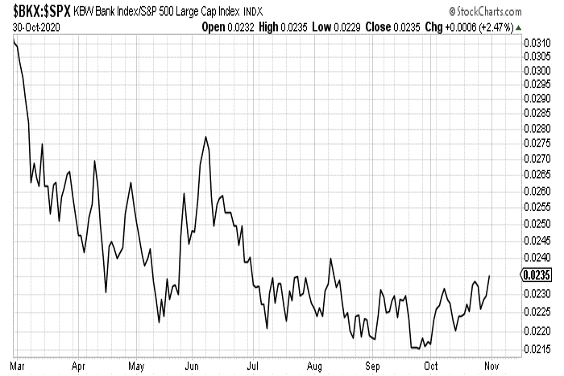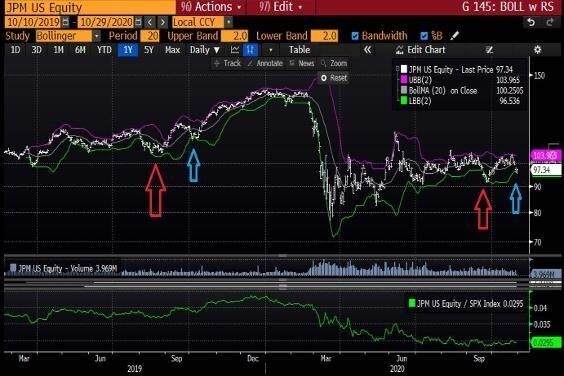Study of DPST, KRE and FAS
- 02/24/2024 – realistic comments on small stocks
Small-Cap Stocks May Be At Risk According To NFIB Data | Seeking Alpha
- 02/24/2024 – this is the effect of friction on leveraged ETFs, be aware!!
XLF (all time high, 40.3 vs 41.17) vs FAS (1/3 less than ATH, 98.82 vs 150)
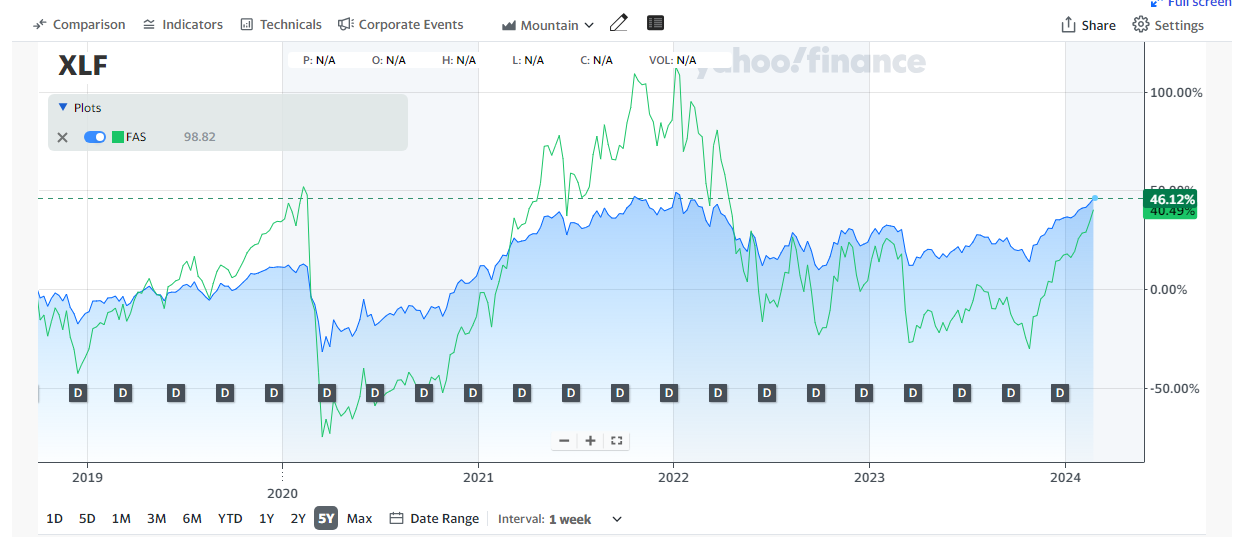
QQQ (all time high, 9% higher than ATH in 2021, 436.78 vs 404) vs TQQQ (0.385 less than ATH in 2021, 60 vs 89), so total is about 50% less than should be ATH
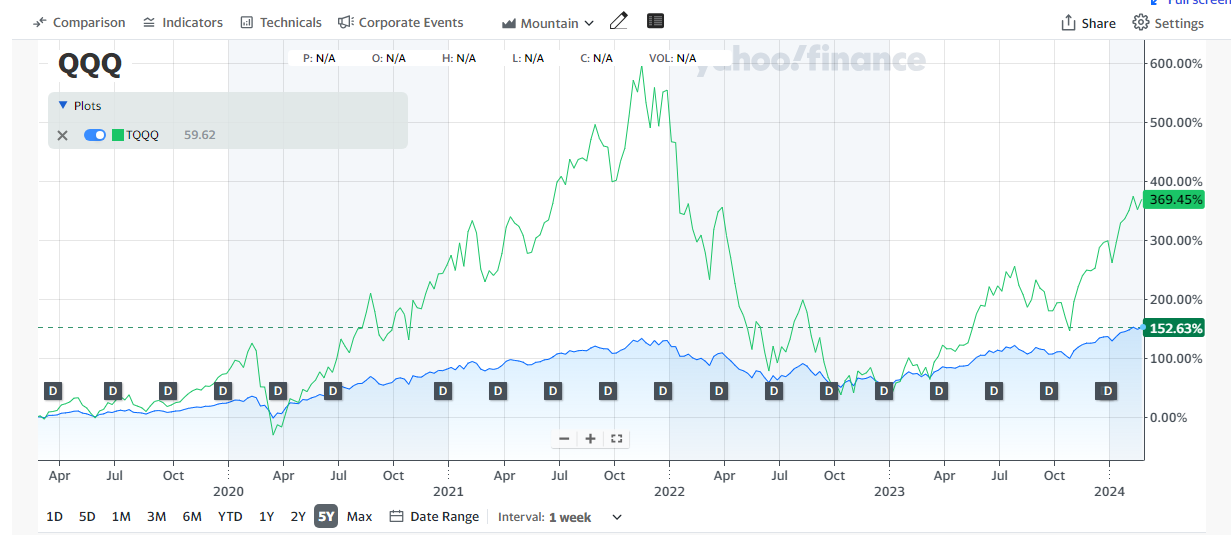
KRE and DPST
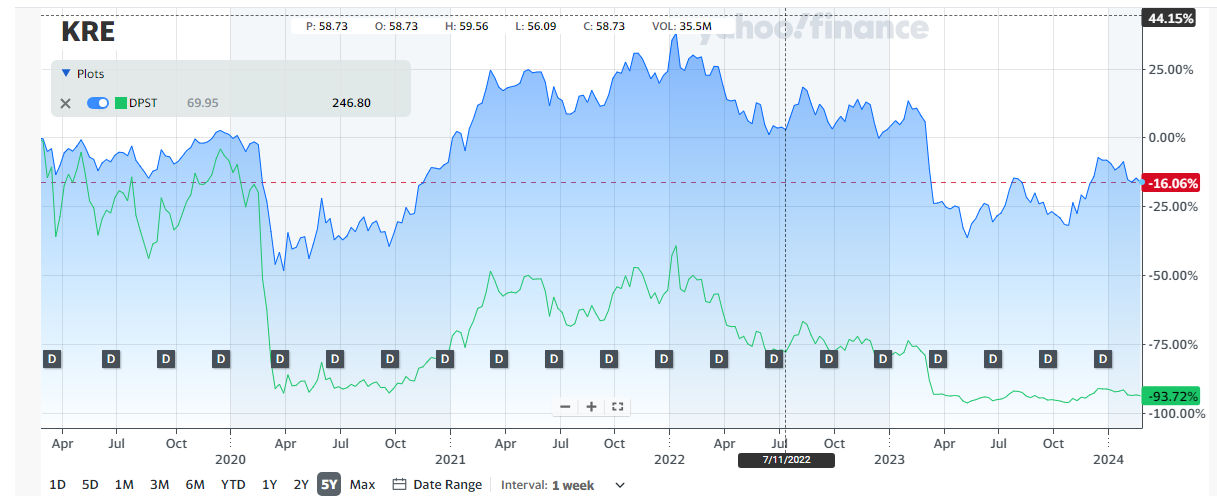
- 02/16/2024 – MSN InvestorPlace
The Latest Inflation Data Is Out – Here’s What It Could Mean for the Federal Reserve (msn.com)
According to FactSet, 79% of S&P 500 companies have now announced quarterly results, and 75% of these companies exceeded analysts’ earnings expectations. The S&P 500 is now anticipated to achieve fourth-quarter earnings growth of 3.2%, up from 2.9% last week and previous expectations for a 1.4% decline in the final week of January.
These positive results have continued to drive all of the major indices higher, with the S&P 500 breaking through 5,000 for the first time ever last Friday.
However, earnings season took a back seat this week as investors shifted their attention to the latest inflation reports and January U.S. sales results.
Consumer Price Index (CPI)
The Consumer Price Index (CPI) reading for January was released first thing Tuesday morning – and the data showed that inflation continues to cool, though not as quickly as economists had hoped. Headline CPI rose 0.3% in January and was up 3.1% in the past 12 months. That was higher than economists’ expectations for headline CPI to rise 0.2% month-over-month and for a 2.9% annual pace. However, it’s still down from December’s 3.4% annual pace.
Core CPI, which excludes food and energy, increased 0.4% in January and was up 3.9% in the past 12 months. This was also a little hotter than forecasts for a 3.7% annual pace and a 0.3% month-to-month rate. The annual pace of core inflation remained in line with December’s 3.9%.
Taking a closer look at the details…
- The food index increased 0.4% (“food at home” was up 0.4%, while “food away from home” rose 0.5%).
- The energy index fell 0.9% over the month thanks largely to a decline in gasoline prices.
- The index for used cars and trucks and the index for apparel both fell over the month.
-
But the big bugaboo with the CPI continues to be Owners’ Equivalent Rent (OER), which accounts for two-thirds of the CPI. OER rose 0.6% in January, which compares to the previous two months’ rise of 0.4%, and is now up 6% in the last 12 months. So, unfortunately, high shelter costs are still pushing the CPI higher.
U.S. January Retail Sales
The January retail sales report was released on Tuesday – and it was weak across the board. The Commerce Department announced that retail sales fell 0.8% in January, which was substantially lower than economists’ expectation for a 0.2% decline. This month-over-month decline marks the largest fall since March 2023.
Out of the 13 categories noted in the report, nine saw decreases from a month ago. Digging a little deeper into the details…
- Leading the decline was building materials, falling 4.1%.
- Sales at miscellaneous stores dropped 3%.
- Gas station sales fell 1.7%.
- Sales at furniture and home stores rose 1.5% and spending at bars and restaurants increased 0.7%.
Overall, this report was just really disappointing. I should also add that the Commerce Department revised the December retail sales numbers from a 0.6% gain to a 0.4% gain.
Producer Price Index (PPI)
This morning, the Labor Department reported a rather disappointing Producer Price Index (PPI) for January that was higher than economists’ expectations.
Now, the PPI is important because it measures the price of goods at the wholesale level. The PPI tells us what producers are paying for goods and services before they reach consumers. It’s considered a good leading indicator of inflation, so the markets were keen to get the report.
So, let’s dig into the numbers…
- PPI rose 0.3% in January and 0.9% in the past 12 months.
- Core PPI, excluding food, energy and trade margins, surged 0.6% in January and rose 2.6% in the past 12 months.
- Excludes food and energy, PPI rose 0.3% in January.
- Wholesale food and energy prices decreased 0.3% and 1.7%, respectively, in January.
The real problem with the wholesale inflation continues to be wholesale service costs, which rose 0.6% in January and is the largest monthly increase in the past 12 months (since January 2023). But the bright spot remains wholesale goods costs, which declined 0.2% in January and was the fourth straight monthly decline.
While this report came in hotter than expected, I do want you to know next month it should fall quite a bit because we’re cutting off a big increase from a year ago. What’s also clear is that the U.S. continues to import deflation from China.
China’s National Bureau of Statistics announced that consumer prices declined -0.8% in January, which is the biggest monthly drop since September 2009. Furthermore, wholesale prices based on the Chinese producer price index, plunged -2.5% in January.
And since the U.S. is importing this deflation from China, the Fed has to be careful because global deflation is spreading.
Reading Between the Lines
So, the big question for the market is: Will the Federal Reserve cut key interest rates on May 1 or June?
Based on the data from this week, I would say that June is more likely, but it is really dependent on market rates. Currently, the 10-year Treasury yield stands at about 4.29%, well below the federal funds rate of 5.25% – 5.50%. So, the Fed is still out of sync with market rates.
- 02/16/2024 – Bloomberg
Fed’s Barr Says Regulators Are Eyeing Commercial Real Estate Risk (yahoo.com)
(Bloomberg) — US regulators are “closely focused” on risks in commercial real estate loans, and have stepped up downgrades of supervisory ratings on lenders amid new strains on their finances, according to the Federal Reserve’s chief bank watchdog.
Supervisors are looking at what banks are doing to mitigate potential losses, how they are reporting risks to their boards and senior management, and whether they have enough reserves and capital to handle CRE loan losses, said Michael Barr, the Fed’s vice chair for supervision, in remarks Friday at Columbia University in New York.
“For a small number of banks with a risk profile that could result in funding pressures for the firm, supervisors are continuously monitoring these firms,” Barr said.
Regulators are tightening scrutiny after turmoil that felled three big regional lenders a year ago, while preparing a new round of international standards that have faced pushback from the industry. With more office and apartment buildings headed for distress, the central bank issued guidelines on Thursday for its annual stress tests that put extra emphasis on identifying risks in commercial property.
Barr cited concern about the impact on banks from the changing economic, interest-rate and financial situations.
“Because of the heightened risk environment and heightened supervisory attention, the Federal Reserve has issued more supervisory findings and downgraded firms’ supervisory ratings at a higher rate in the past year,” Barr said. “In addition, we have increased our issuance of enforcement actions.”
Barr is leading efforts to upgrade oversight after criticism by the Fed’s inspector general that followed the failure of Silicon Valley Bank a year ago. The approach that supervisors use for mid-size bank examinations “did not evolve with SVB’s growth and increased complexity,” and didn’t effectively transition the firm to the process used to examine large banks, according to the inspector general.
The Fed also has taken heat for the number of bank examiners who’ve left and other woes with front-line supervisory staff.
Read More: Bank Examiner Exits Risk Undermining Regulators’ Post-SVB Fixes
Barr said the Fed is looking to improve the speed, force and agility of its supervision to match the risks, size and complexity of the banks it oversees. Meanwhile, he said, as a regional bank gets bigger and more complex, there’s an expectation that its executives should also scale up their ability to manage the firm’s risk along the way.
“The goal is that the transition to heightened supervision for fast-growing banks is more of a gradual slope and not a cliff,” he said.
Banks still have mark-to-market losses on securities they hold due to higher interest rates, Barr said. That’s the same issue that led to SVB’s downfall. Other lurking concerns he cited include cybersecurity and the potential that artificial intelligence might be used to attack the banking system.
Read More: Dozens of Banks Rapidly Piled Up Commercial Property Loans
Commercial real estate isn’t all the same and it’s not all bad, Barr said. Some cities are doing better than others, he noted, and even within a given city, some high-end properties and buildings are faring better than others.
“So supervisors are looking under the hood” at the variety of CRE risks, Barr said. “We’re really looking at a very granular level.”
- Problems for the US commercial real estate sector seem to be getting worse — and spreading.
- Steeper interest payments, tighter bank lending, and declining asset values have slammed the sector.
- Some bold buyers plan to capitalize on the chaos by scooping up bargains.
The tremors rattling US commercial real estate are spreading to other countries and sectors, and threaten to escalate into a financial earthquake as refinancing deadlines loom.
- 02/16/2024 – Tilson
1) Right now, two of my colleagues have teamed up for the first time ever to sound the alarm on something they see brewing in the markets…
2) In my e-mail 10 days ago, my friend who’s an expert in the financial sector made the case for why he’s long Wells Fargo (WFC), despite being bearish on banks in general. As I said then:
My friend thinks this makes Wells Fargo a good value compared with the rest of the large banks, with a catalyst being an eventual exit from the regulatory doghouse and potential return to a more normal historical valuation and increased capital return to investors.
Sure enough, as CNBC reports, this news came out yesterday… triggering a 7.2% jump in the stock: Wells Fargo says regulator has lifted a key penalty tied to its 2016 fake accounts scandal. Excerpt:
- 02/16/2024 – By Nick Timiraos, Reporter
The Fed’s Preferred Inflation Gauge Likely Posted Largest Rise Since Early 2023 (wsj.com)
The Federal Reserve’s preferred inflation gauge is likely to show that price pressures firmed in January, ending a streak of much better inflation readings.
Core inflation—as measured by the personal-consumption-expenditures price index, which will be released later this month by the Commerce Department—is likely to have increased by 0.4% in January, according to forecasts from a handful of Wall Street economists.
Core inflation excludes volatile food and energy prices, which forecasters believe makes it better capture underlying price trends.
Forecasters are able to come up with reasonably accurate forecasts of the core PCE index after they see price data from two other inflation indexes produced by the Labor Department: the producer-price index, which was released today, and the consumer-price index.
Omair Sharif of Inflation Insights and Skanda Amarnath of Employ America both project the core PCE index rose 0.36% in January. Economists at UBS, Goldman Sachs and Morgan Stanley project increases of 0.42%, 0.43% and 0.43%, respectively.
Those readings would be the highest since February 2023, but they would still run below the 0.51% increase in January 2023. As a result, a reading of just below 0.4% would lower the 12-month change in the core PCE index to 2.8%, from 2.9% in December. A reading just above 0.4% would hold the 12-month rate steady from December.
At a six-month annualized rate, core PCE inflation is likely to be around 2.5% in January, up from 1.9% in November and December, according to Alan Detmeister, an economist at UBS.
Detmeister expects headline inflation as measured by the PCE rose by 0.35% in January, lowering the 12-month rate to 2.4% from 2.6%. The Fed targets 2% inflation.
Friday’s Economic News Highlight: PPI Inflation Comes in Hotter Than Forecast (wsj.com)
Another inflation gauge is in the spotlight, following Tuesday’s stronger-than-expected consumer-price index.
The producer price index, which is just out, rose slightly more than expected in January. The update weighed on stock futures and pushed benchmark bond yields above 4.3%.
Just Out:
The PPI rose by 0.3% last month, topping the 0.1% forecast by economists. The index declined 0.1% in December.
Housing starts fell by 14.8% to a seasonally adjusted annual rate of 1.3 million in January. Economists had forecast 1.45 million.
- 02/15/2024 – Tilson, be aware of potential shock from Commercial real estate
A recent Bloomberg article caught my eye – it underscores the bloodbath in commercial real estate: The Brutal Reality of Plunging Office Values Is Here. Excerpt:
Since the COVID-19 pandemic upended the use of real estate around the world, lenders have had little incentive to get tough on borrowers squeezed by soaring interest rates and take on loans that had lost value. Transactions ground to a halt as potential sellers were unwilling to unload buildings at distressed prices – an outcome that allowed them to pretend that nothing had fundamentally changed…
Across the country, deals are starting to pick up, revealing just how far real estate prices have fallen. That’s spurring widespread concern about losses that can ripple across the global financial system – as underscored by the recent turmoil unleashed by New York Community Bancorp, Japan’s Aozora Bank Ltd. and Germany’s Deutsche Pfandbriefbank AG as they took steps to brace for bad loans.
In Manhattan, brokers have started to market debt backed by a Blackstone Inc.-owned office building at a roughly 50% discount. A prime office tower in Los Angeles sold in December for about 45% less than its purchase price a decade ago. Around the same time, the Federal Deposit Insurance Corp. took a 40% discount on about $15 billion in loans it sold backed by New York City apartment buildings.
Charlie Bilello, in his latest Week in Charts, also shared data on what’s causing this.
As he shows in this chart, the office vacancy rate in the U.S. is up to 19.6% – the highest level in history:

And as he says with his next chart:
The main reason: workers are not going back to the pre-COVID model of five days per week in the office, with most major cities hovering around 50%. As long commercial leases continue to roll off, that means less space is needed going forward, with increasing vacancies over time.
- 02/08/2024 – Tilson
Despite my friend’s overall bearishness toward the sector, he does own one large-cap bank, Wells Fargo (WFC) – which I discussed in Tuesday’s e-mail – as well as five idiosyncratic “special situation” small-cap and even microcap bank stocks. I discussed two of these in yesterday’s e-mail: Eastern Bankshares (EBC) and Ponce Financial (PDLB).
Before I turn to his final three favorite stocks, I want to share my friend’s thoughts on general areas in which he regularly makes money…
One is when he owns the stock of a small bank that’s acquired at a healthy premium. Recently, some of this activity, he says, is being driven by credit unions, which have an advantage as acquirers relative to their corporate-bank peers because they are quasi-nonprofits owned by their depositors (or “members”).
As such, they benefit from a weird and unjustified loophole in which they don’t pay taxes (the credit-union lobby spends more money than the National Rifle Association to protect this status).
My friend thinks Oakland, California-based Summit Bancshares (SMAL), a thinly traded microcap with only a roughly $50 million market cap, is likely to be acquired.
Another attractive bank stock my friend owns is W.T.B. Financial (WTBFB). It’s the holding company for Washington Trust Bank, a community bank based in Spokane, Washington, with $11.4 billion in assets.
I was surprised to hear that my friend’s final favorite idea isn’t a bank – it’s aircraft-engine leasing company Willis Lease Finance (WLFC).
It trades at only 70% of tangible book value – and he thinks book value is understated because Willis depreciates the new engines it buys on a straight-line basis over 15 years to a 55% residual value and carries them on the balance sheet at the lesser of appraised value or depreciated value.
In reality, the value of the engines has actually appreciated over the first five years due to inflation and scarcity value driven by supply-chain disruptions.
- 02/07/2024 – Tilson
Here’s a picture of us visiting the Virgin Galactic (SPCE) spaceport – a stock we recommended at Empire at $10.20 per share shortly before it soared (we recommended partial sales after it doubled and then tripled, with our final exit recommendation at $50 per share, just before it cratered – one reader made $10 million on this one idea!):
Picking up where I left off in yesterday’s e-mail, I’m continuing my series on the banking sector…
Despite my friend’s overall bearishness toward the sector, he does own one large-cap bank, Wells Fargo (WFC), as well as some idiosyncratic “special situation” small-cap and even microcap bank stocks.
Turning to my friend’s favorite off-the-beaten-track bank stocks…
He likes Eastern Bankshares (EBC), which he says is “the jewel of the Boston banking market” – one of the most attractive in the country because of the area’s many large educational institutions as well as health care and tech companies.
His favorite was to play this is Ponce Financial (PDLB), which operates in the Bronx. It was sort of a ho-hum bank, with $266 million of common equity, but then it applied for the maximum from the Treasury Department, which handed it $225 million!
The pain in commercial real estate has been slow to unfold. While changes in office habits that have hollowed out downtowns are nearly four years old and rates began rising two years ago, landlords have been cushioned by rent from tenants on long-term leases that have been gradually burning off.
In all, more than $2.2 trillion of U.S. commercial property loans are set to come due by 2027, according to the data tracker Trepp. Many banks have given short extensions to loans that were due to expire over the past two years, putting the day of reckoning off to the future.
“The commercial real-estate pain in the office sector is just starting,” Anne Walsh, the chief investment officer of Guggenheim Partners Investment Management, said last month at the World Economic Forum in Davos, Switzerland.
She said small and midsize lenders especially face substantial numbers of loans to office landlords that refinance in the next 24 months, and likened the situation to a “rolling recession” for banks that could drag on for some time.
Some of the biggest risks come at the maturity of loans, which tend to run five to 10 years in term. As cheap loans from an era of low rates and high prices come due, landlords are increasingly unable to find new loans to replace them.
The warnings revived fears that troubles in the banking sector could resume after last March’s banking crisis, though many investors remain sanguine that most banks have ample reserves to absorb losses. Falling interest rates could also help provide relief among stressed borrowers. The Federal Reserve this week signaled it was thinking about when to lower interest rates but hinted a cut wasn’t imminent.
Regulators have been watching carefully, and worry about the prospects for further contagion into the financial sector, particularly if there were a significant recession.
- 05/06/2023 – Tilson
despite his overall bearishness toward the sector, he does own some idiosyncratic “special situation” stocks, all of which are small caps and even microcaps.
There’s one exception, however: He owns Wells Fargo (WFC). I’ll share his thoughts on it here and save the smaller stocks for tomorrow’s e-mail…
He argues that Wells Fargo was somewhat saved by the fact that, due to past scandals, regulators had imposed an asset-cap rule, which restricts its asset growth to no more than 3% annually. As he says, the asset cap pushed the company to focus on more profitable businesses while shrinking or ridding itself of less profitable businesses.
The asset cap also proved to be a blessing because it prohibited Wells Fargo from taking all of the extraordinarily high level of deposits that flooded other banks, which, as my friend discussed last week,
However, given his overall bearishness on the banking sector, he also says that he would keep the stock as a smaller position and/or offset it with a short position in the sector.
- 02/05/2024 – Tilson
Latest thoughts on the banking sector (part 4) | Stansberry Research
- this smartest bank analyst correctly predicted the headwinds of bank sector
- Despite the many headwinds he has outlined – which I’ve shared in my recent e-mails, and will continue with today – and the fact that analysts expect 72% of banks will see earnings decline in 2024, bank stock valuations are back to their 10-year average price-to-tangible-book-value multiple
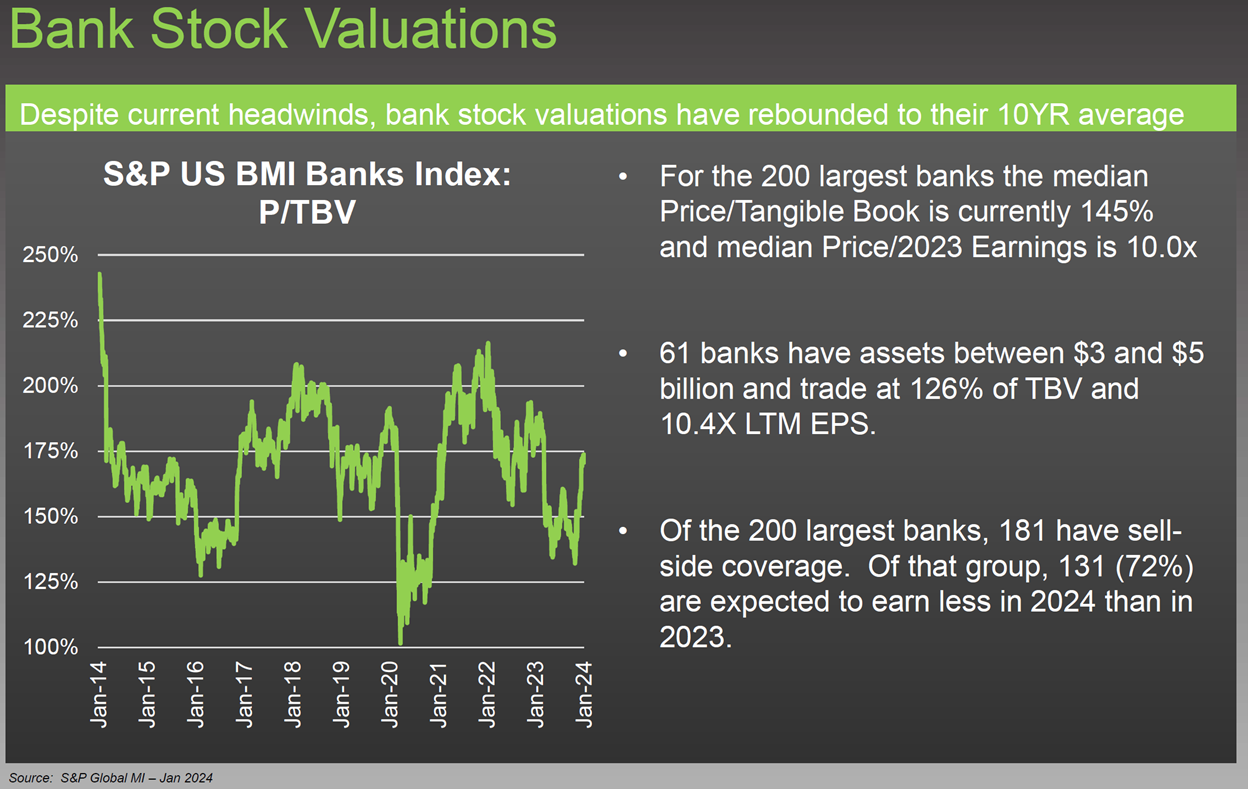
- In reality, the situation is even worse… because banks’ book values are inflated due to the fact that they aren’t required to do fair-value marks on their held-to-maturity (“HTM”) securities and loan portfolios. If banks had to mark both down by a mere 5%, this would reduce their tangible book value by 33%
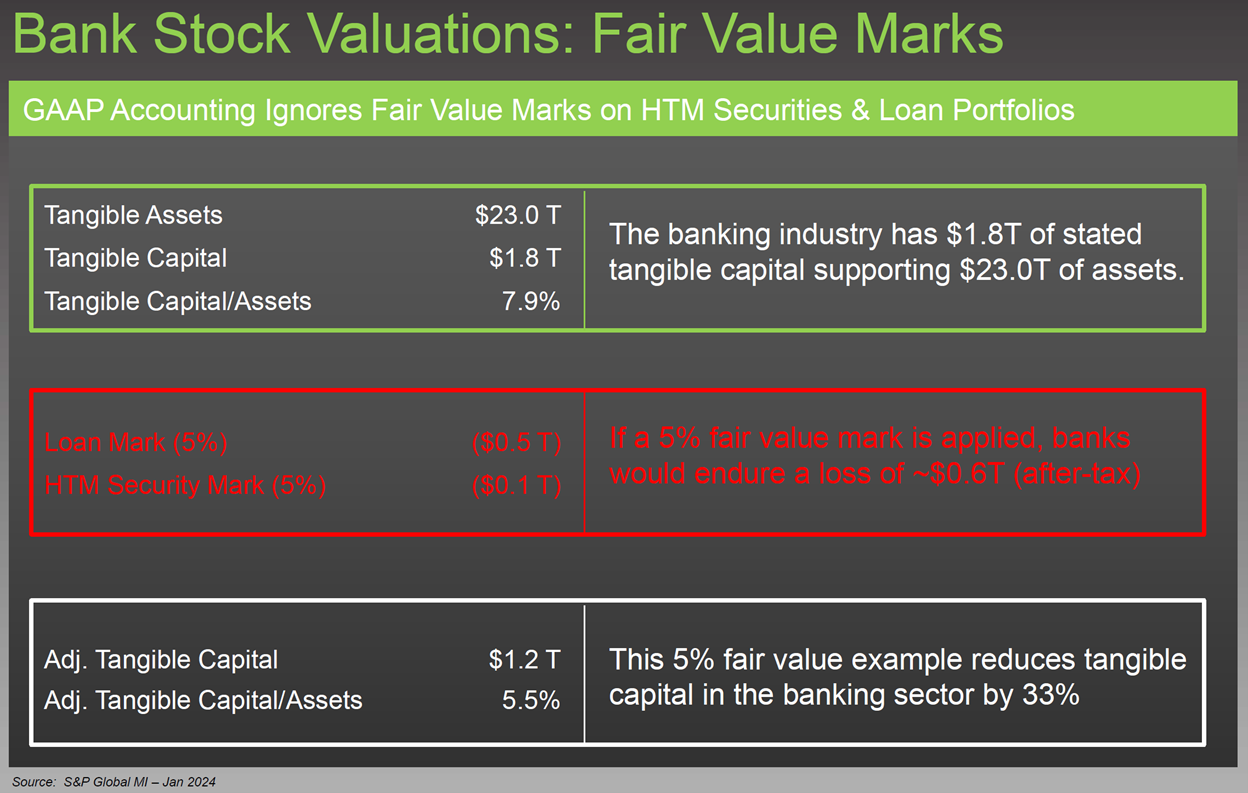
- Historically, one way investors can make money owning smaller banks is if they get acquired, usually at a nice premium, which should be happening for many reasons – but the sector headwinds are making it unlikely. As a result, bank merger and acquisition (M&A) volume has plunged to multidecade lows.
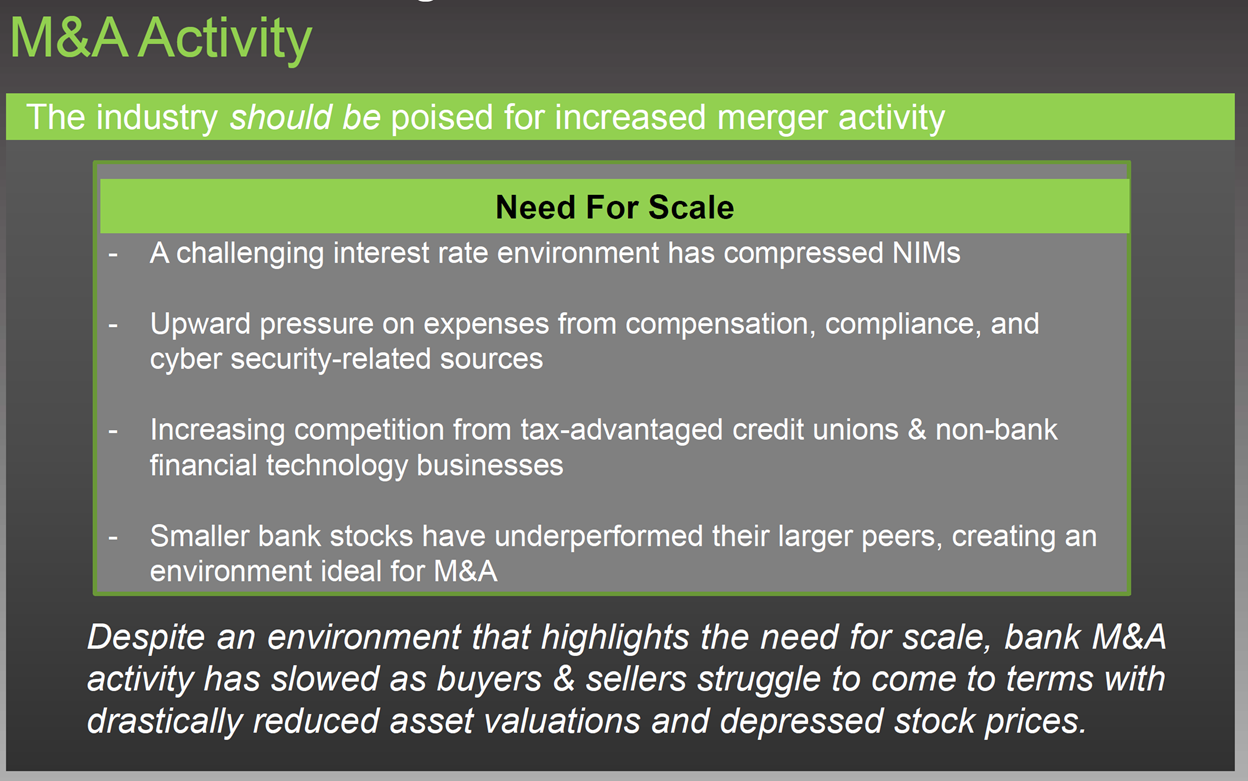
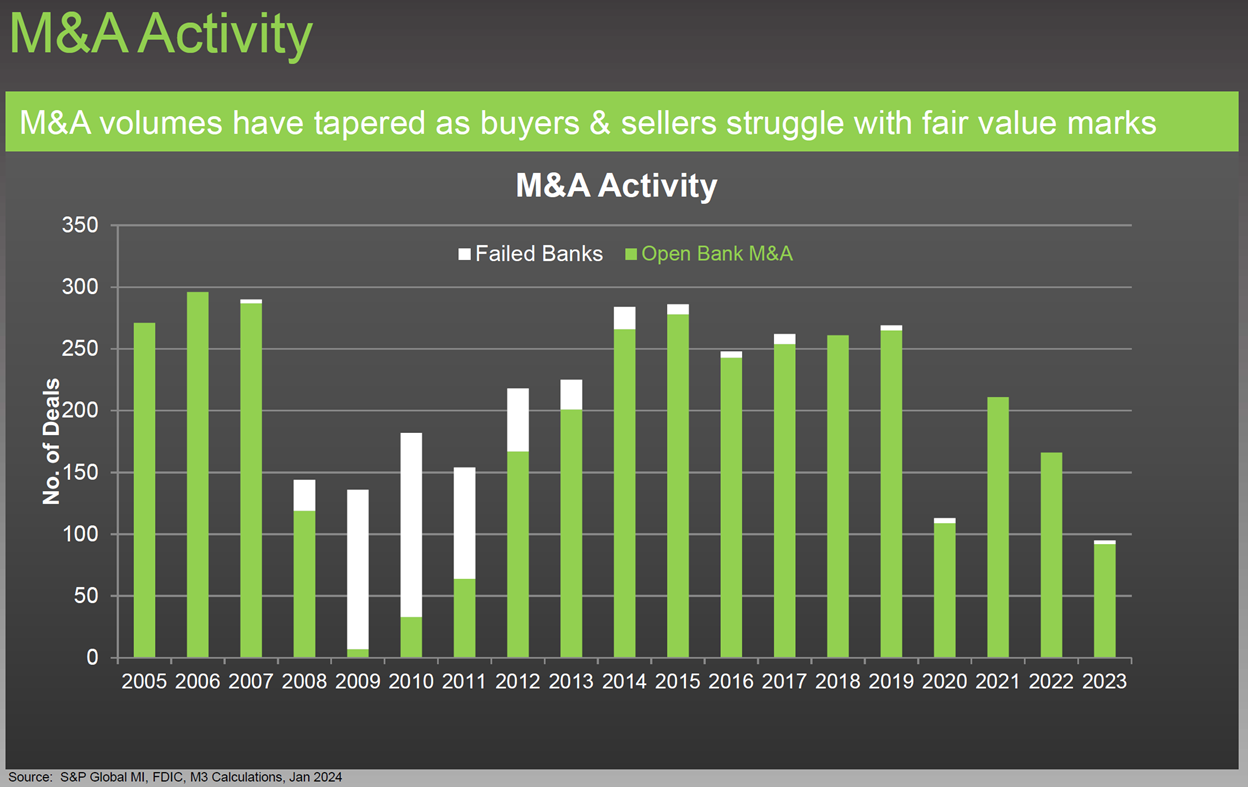
- conclusions
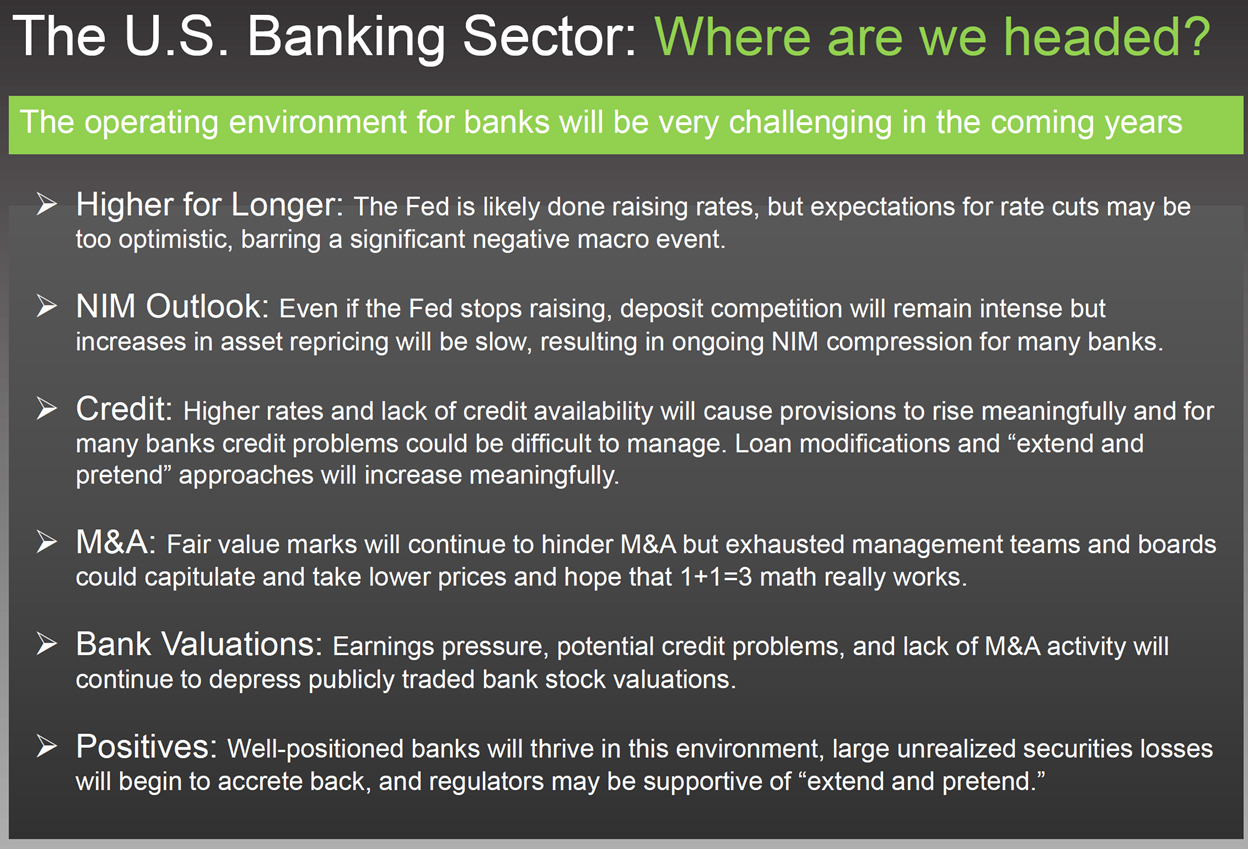
I summarized these in Tuesday’s e-mail:
- There are many headwinds for the banking sector: continued high interest rates, credit risk, deposits declining and becoming more expensive, etc.
- As he puts it: “A pretty positive scenario has to play out for valuations to be warranted – bank stocks are priced for perfection.”
- As such, he has sold all of his regional-bank stocks, including [Metropolitan Bank (MCB), Western Alliance Bancorp (WAL), and Zions Bancorp (ZION)].
In addition to NYCB, Japan’s Aozora Bank Ltd. dropped more than 20% after warning of a loss tied to investments in U.S. commercial real estate, and Deutsche Bank AG more than quadrupled its U.S. real estate loss provisions in the fourth quarter when compared to the year earlier.
I’m not sure this is necessarily symbolic of an immediate meltdown for all banks, but it certainly highlights all the risk that is in the banking system right now from both a credit and liquidity perspective.
Latest thoughts on the banking sector (part 2) | Stansberry Research
New York Community Bancorp Headed for Worst Close Since 2000 After Downgrade (wsj.com)
- 02/05/2024 – Powell on 60 minutes Read the Full Transcript of Powell’s Interview With CBS’s ‘60 Minutes’ (yahoo.com)
PELLEY: The value of commercial office buildings all across the country is dropping as people work from home. Those buildings support the balance sheets of banks all across the country. What is the likelihood of another real estate-led banking crisis?
POWELL: I don’t think that’s likely. So, what’s happening is, as you point out, we have work-from-home, and you have weakness in office real estate, and also retail, downtown retail. You have some of that. And there will be losses in that.
We looked at the larger banks’ balance sheets, and it appears to be a manageable problem. There’s some smaller and regional banks that have concentrated exposures in these areas that are challenged.
And, you know, we’re working with them. This is something we’ve been aware of for, you know, a long time, and we’re working with them to make sure that they have the resources and a plan to work their way through the expected losses. There will be expected losses.
It feels like a problem we’ll be working on for years. It’s a sizable problem. I don’t think — it doesn’t appear to have the makings of the kind of crisis things that we’ve seen sometimes in the past, for example, with the global financial crisis.
PELLEY: You believe it’s a manageable problem?
POWELL: I think it appears to be
PELLEY: We’re not gonna see bank failures across the country as we did in 2008?
POWELL: I don’t think there’s much risk of a repeat of 2008. I also think, you know, we need to be careful about making proclamations about the — particularly about the future. Things have surprised us a lot. But no, on this, on this, I do think it’s a manageable problem. I think we’re doing a lot to manage it.
There will be certainly — there will be some banks that have to be closed or merged out of, out of existence because of this. That’ll be smaller banks, I suspect, for the most part. You know, these are losses. It’s a secular change in the use of downtown real estate. And the result will be losses for the owners and for the lenders, but it should be manageable.
Given the volatility of market and long term perspective of long term financial industry, I plan to buy call options of FAS (or use call options of FAZ to hedge my portfolio).
- 05/03/2023 – Tilson
Regional bank stocks took a beating yesterday: Regional Bank Stocks Close at Lowest Level Since 2020.
For further insight into the reasons behind the sell-off, see this opinion piece from the U.K.’s Telegraph (subscription required, but you can bypass it by using Pocket, about which I wrote here): Half of America’s banks are potentially insolvent – this is how a credit crunch begins.
I think these fears are way overblown and that yesterday’s sell-off – and this hysterical, over-the-top, wrongheaded article – may mark a bottom for the sector, for two main reasons…
First, this “crisis” was caused by the Fed’s unprecedented sharp increases in interest rates, which you can see in this chart from the Wall Street Journal:
But here’s the thing: if the banking sector truly does enter a crisis, the Fed can quickly cease or reverse its rate hikes, eliminating the bondholders’ losses (here’s a good article in the Wall Street Journal trying to read the tea leaves on this: What a Fed Debate 17 Years Ago Reveals About Its Rate Deliberations Now).
This is a fundamental difference between today’s situation versus the global financial crisis, when banks had actual losses in their loan portfolios.
“Ah, but what about the losses banks are likely to incur in the coming years in their commercial loan portfolios?”
Banks will indeed take substantial losses… but investors are forgetting that these losses won’t be sudden, but rather spread out over time – which means that banks can offset losses with profits.
This is a topic I discussed at length in the Wells Fargo (WFC) chapter of my 2009 book about the financial crisis, More Mortgage Meltdown: 6 Ways to Profit in These Bad Times. Here are excerpts from the conclusion of that chapter:
- Potential future catalyst
- higher interest rate income when interest rate hikes
- Potential future risks
- flat yield curve, lower expected revenue contributions from non-interest revenue, higher expenses (tech and wages), potentially higher provisions are meaningful headwinds
- European banking and the commodity markets there…which are a complete trainwreck
- In general, DPST and financials are driven by a number of key factors:
- Go-to website for financial (DPST) stocks investment
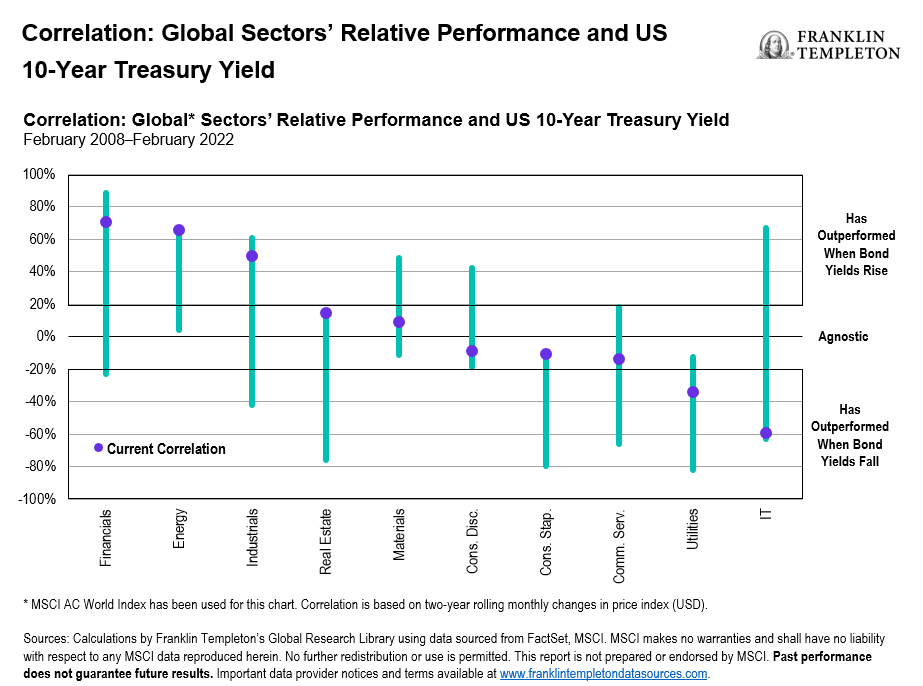
- 08/01/2023 – Tilson
In my July 20 e-mail, I highlighted how I nailed the bottom of the crash in small and regional bank stocks in my May 3 and May 4 e-mails. In the latter, I quoted from “the smartest bank analyst I know,” who said that day:
The other thing that the markets seem to have wrong is they don’t realize that banks have reserved for loan losses and are still going to earn some money as we go through a potential credit cycle. Take Zions Bancorp for example: they have $618 million of loan loss reserves and are expected to earn another $800 million this year. Even if they only earn half of that they still have the power to cover a lot of credit losses.
Not that analysis seems to matter right now, as sentiment in the bank space is as bad as we can ever remember it…
The shorts are being very aggressive in some of the banks like MCB, WAL, ZION, etc. If there is even a hint of an improvement in deposit insurance, we could see a short squeeze for the ages that sends these stocks up 20%-plus in a matter of minutes, and many of them would still be dirt cheap.
Since then, the three stocks he recommended, Metropolitan Bank (MCB), Western Alliance Bancorp (WAL), and Zions Bancorp (ZION), are up 128%, 185%, and 92%, respectively, which has led to articles like this one in the New York Times, How Regional Banks Got Healthy Again, and this one in the Wall Street Journal, Banks Lean On ‘Hot’ Deposits to Shore Up Balance Sheets.
So is it time to take some profits?
I checked in with my friend yesterday to get his latest thoughts, which he gave me permission to share:
We would say it is quite generous to say that regional banks are suddenly healthy again. Yes, the fear has calmed, but the trends with funding costs are really awful and the earnings outlook for banks is definitely challenged. Banks still have very large amounts of long-term fixed rate loans and securities on their books, so as rates and funding costs continue to rise the portions of their balance sheet that are underwater grows larger.
If the Fed keeps on its path of raising, it is going to make matters a lot worse. There are still a handful of fairly large banks that are very thin on capital if you mark-to-market the balance sheet, and some that even get totally wiped out. The ugliest bank that nobody is talking about anymore is Charles Schwab (SCHW). It is crazy they passed the stress test, but then again Silicon Valley Bank and First Republic probably would have passed that stress test as well.
It feels like all the buying recently has been short covering and passive money driven as bank earnings expectations were so low it wasn’t difficult for most banks to beat the estimate. Overall, we have been reducing long exposure and adding to shorts as we think this bounce is a bit overdone.
- 05/01/2023 – as expected: the FDIC outlines three options for deposit insurance reform. But DPST/KRE tanks which might be caused by potential rate hike the day after tomorrow and Buffett’s/Munger’s warning on Commercial Real Estate crisis to bank. Question: when will congress work on this subject?
FDIC Signals Support for Narrow Changes to Deposit Insurance – WSJ
As part of its analysis, the FDIC outlines three options for deposit insurance reform:
- Limited Coverage: Maintaining the current deposit insurance framework, which provides insurance to depositors up to a specified limit (possibly higher than the current $250,000 limit) by ownership rights and capacities.
- Unlimited Coverage: Extending unlimited deposit insurance coverage to all depositors.
- Targeted Coverage: Offering different deposit insurance limits across account types, where business payment accounts receive significantly higher coverage than other accounts.
Of the three options outlined in this report, the FDIC believes targeted coverage best meets the objectives of deposit insurance of financial stability and depositor protection relative to its costs. These proposed options would require Congressional action, though some aspects of the report lie within the scope of the FDIC’s rulemaking authority.
- 05/01/2023 – the same warning (as that from Buffett) from Munger
Charlie Munger: US banks are ‘full of’ bad commercial property loans
Please use the sharing tools found via the share button at the top or side of articles. Copying articles to share with others is a breach of FT.com T&Cs and Copyright Policy. Email licensing@ft.com to buy additional rights. Subscribers may share up to 10 or 20 articles per month using the gift article service. More information can be found here.
https://www.ft.com/content/da9f8230-2eb1-49c5-b63a-f1507936d01b
The comments from the 99-year-old investor and sidekick to billionaire Warren Buffett come as turmoil ripples through the country’s financial system, which is reckoning with a potential commercial property crash following a handful of bank failures. “It’s not nearly as bad as it was in 2008,” the Berkshire Hathaway vice-chair told the Financial Times in an interview. “But trouble happens to banking just like trouble happens everywhere else. In the good times you get into bad habits . . . When bad times come they lose too much.”
Please use the sharing tools found via the share button at the top or side of articles. Copying articles to share with others is a breach of FT.com T&Cs and Copyright Policy. Email licensing@ft.com to buy additional rights. Subscribers may share up to 10 or 20 articles per month using the gift article service. More information can be found here.
https://www.ft.com/content/da9f8230-2eb1-49c5-b63a-f1507936d01b
Berkshire has a long history of supporting US banks through periods of financial instability. The sprawling industrials-to-insurance behemoth invested $5bn in Goldman Sachs during the 2007-08 financial crisis and a similar sum in Bank of America in 2011. But the company has so far stayed on the sidelines of the current bout of turmoil, during which Silicon Valley Bank and Signature Bank collapsed. “Berkshire has made some bank investments that worked out very well for us,” said Munger. “We’ve had some disappointment in banks, too. It’s not that damned easy to run a bank intelligently, there are a lot of temptations to do the wrong thing.” Their reticence stems in part from lurking risks in banks’ vast portfolios of commercial property loans. “A lot of real estate isn’t so good any more,” Munger said. “We have a lot of troubled office buildings, a lot of troubled shopping centres, a lot of troubled other properties. There’s a lot of agony out there.” He noted that banks were already pulling back from lending to commercial developers. “Every bank in the country is way tighter on real estate loans today than they were six months ago,” he said. “They all seem [to be] too much trouble.”
Charlie Munger reportedly warns of trouble for the U.S. commercial property market
- 04/28/2023 – Mr. Barr called for re-evaluating how regulators treat deposits above a $250,000 federal insurance limit. here is the report Fed-SVB-Barr
Fed Report on Silicon Valley Bank Collapse Finds Regulators Failed to Act – WSJ
The Federal Reserve’s banking supervisors failed to take forceful action to address growing problems at Silicon Valley Bank before it collapsed last month, the central bank’s top regulator said, signaling a broad push to toughen rules on the industry.
Mr. Barr on Friday called for revamping a range of rules that apply to banks with more than $100 billion in assets, and he called for re-evaluating how regulators treat deposits above a $250,000 federal insurance limit. Both banks had a large amount of such deposits, which fled quickly as trouble mounted.
Michael Barr, the Fed’s vice chair for supervision, said supervisors didn’t fully appreciate the extent of the vulnerabilities as SVB grew in size and complexity. When supervisors did find risks, they didn’t take sufficient steps to ensure the firm fixed those problems quickly enough, he said in a report Friday.
excerpt from Barr’s report
- Contagion from the failure of SVB threatened the ability of a broader range of banks to
provide financial services and access to credit for individuals, families, and businesses.
Fast and forceful action by the Federal Reserve, the Federal Deposit Insurance
Corporation, and the Treasury Department helped to contain the damage, but weaknesses in supervision and regulation must be fixed. - we are also going to evaluate how we supervise and regulate liquidity risk, starting with the risks of uninsured deposits. Liquidity requirements and models used by both banks and supervisors should better capture the liquidity risk of a firm’s uninsured deposit base. For instance, we should re-evaluate the stability of uninsured deposits and the treatment of held to maturity securities in our standardized liquidity rules and in a firm’s internal liquidity stress tests. We should also consider applying standardized liquidity requirements to a broader set of firms. Any adjustments to our liquidity rules would, of course, go through normal notice and comment rulemaking and have appropriate transition rules, and thus would not be effective for several years.
- Oversight of incentives for bank managers should also be improved. SVB’s senior
management responded to the incentives approved by the board of directors; they were
not compensated to manage the bank’s risk, and they did not do so effectively. We should consider setting tougher minimum standards for incentive compensation programs and ensure banks comply with the standards we already have - First, the combination of social media, a highly networked and concentrated depositor
base, and technology may have fundamentally changed the speed of bank runs. - a firm’s distress may have systemic consequences through contagion
Fed report on SVB collapse faults bank’s managers — and central bank regulators
Areas the Fed is likely to focus on include the types of uninsured deposits that raised concerns during the SVB drama, as well as a general focus on capital requirements and the risk of unrealized losses that the bank had on its balance sheet.
- 04/27/2023 – uncertainty of FRC
U.S. officials lead urgent rescue talks for First Republic – sources
First Republic is contemplating a major hit, and even a total loss for shareholders, as part of the options that would prevent U.S. regulators from taking it over, one of the sources said.
White House: Monitoring situation at First Republic, could step in if needed
Pressed to explain the administration’s views on whether to protect depositors in First Republic, as it did in the cases of SVB and Signature, Jean-Pierre said, “We have proven how we have moved really quickly in … taking decisive and forceful actions in the past, and I can assure you that you’ll see that again from this administration.”
Why No Buyer Has Emerged for First Republic – WSJ
There are some possible offsets. A bank that buys the assets at fair value might then quickly sell them to pay down expensive government borrowing or to cover the return of big banks’ emergency $30 billion in unsecured deposits. That would reduce the bank’s size and capital needs. The acquirer could also benefit over time as the acquired assets rise in value or pay off.
But the tricky math for an acquirer might help explain the current state of affairs, in which First Republic plans to restructure its business. One other plan under consideration, to have a group of banks buy assets from First Republic at above-market prices, could effectively socialize the costs of acquisition that would otherwise be borne by one buyer. This might be one reason for banks to hesitate in helping out now, for fear it would only allow an ultimate buyer of First Republic to get a far better deal. But getting a form of equity as part of the deal would help the group of banks all benefit in that scenario.
If that can’t be worked out, an alternative form of a full acquisition might be a government-arranged sale in which the acquirer gets a federal backstop for its losses.
The $30 billion reason for Wall Street to save First Republic ASAP
Why big banks are reluctant to rescue First Republic again
- 04/27/2023 – more CRE problem might worsen the bank industry, so be aware. Stress on the office-building market across the U.S. is not an isolated problem, because of the effect on tax levies and nearby shops and the potential impact on the financial sector, especially regional banks that are big lenders on commercial real estate.
Fire Sale: $300 Million San Francisco Office Tower, Mostly Empty. Open to Offers. – WSJ
One building, a 22-story glass and stone tower at 350 California Street, was worth around $300 million in 2019, according to office broker estimates.
That building now is for sale, with bids due soon. They are expected to come in at about $60 million, commercial real-estate brokers say. That’s an 80% decline in value in just four years.
This is how dire things have become in San Francisco, an extreme form of a challenge nationwide. Nearly every large U.S. city is struggling, to some degree, with reduced office-worker turnout since the pandemic spurred remote work. No market was hit harder than San Francisco, for reasons including its high costs, reliance on a tech industry quick to embrace hybrid work, and quality-of-life issues such as crime and homelessness.
Stress on the office-building market across the U.S. is not an isolated problem, because of the effect on tax levies and nearby shops and the potential impact on the financial sector, especially regional banks that are big lenders on commercial real estate.
About $80 billion worth of loans backed by U.S. office buildings come due this year, according to data firm Trepp Inc. Most will need to be refinanced, at a time of higher interest rates and lower occupancy, threatening lenders with losses.
Wells Fargo & Co. recently said the volume of its office-building-backed loans that are classified as “nonaccrual”—meaning the bank no longer expects full interest and principal payment—jumped to $725 million in the first quarter from $186 million in the 2022 fourth quarter.
“This could be seen as a bellwether for the value destruction in the urban office market nationally,” he said, “especially those markets that are more technology and financial services-centric.”
Nearly 30% of San Francisco’s office space is vacant, which is more than seven times the rate before the pandemic hit, and the biggest increase of any major U.S. city, according to commercial real estate services firm CBRE Group Inc.

- 04/26/2023
First Republic Bank Is a Problem With No Easy Solution – WSJ
First Republic Bank FRC -29.32%decrease; red down pointing triangle is running up against a grim reality in its fight for survival: There are seemingly no good options.
Any solution would likely require assistance from regulators, the government or other lenders. But the darkening economic outlook, bad lending decisions and limits on Washington policy makers pose hurdles for any intervention.
That worked for a short period. But it didn’t solve the bigger issues: First Republic specialized in making huge mortgages, often at low rates, to wealthy borrowers, and that business model no longer works. Now the bank is sitting on a pile of loans that are mispriced for the current interest-rate environment.
- 04/25/2023 – still more sells than buys
Corporate Insiders Step Up Stock Buying After Banking Turmoil – WSJ
The uptick in insiders’ share purchases signals corporate optimism, reassuring some investors


- 04/25/2023 – Tilson
This front-page WSJ story highlights the woes in the commercial real estate sector: Commercial Real-Estate Woes Run Deeper Than in Past Downturns. Excerpt:
Commercial real estate has experienced its share of busts in recent decades. This one is different.
Landlords are contending simultaneously with a cyclical market downturn and with secular changes in the way people work, live and shop. The sudden surge in interest rates caused property values to fall, while the rise of remote work and e-commerce are reducing demand for office and retail space.
Investors and economists say these two forces haven’t come together on this scale since the 1970s, when a recession followed surging oil prices and a stock-market rout while new technologies enabled jobs to move out of major cities. This time, the pandemic is largely responsible for accelerating the commercial property upheaval.
The U.S. office vacancy rate reached a milestone in the first quarter when it rose to 12.9%, exceeding the peak vacancy rate during the 2008 financial crisis. Despite low unemployment, that figure marked the highest vacancy rate since data firm CoStar Group Inc. began tracking it in 2000.
It is unknown how bad the commercial property downturn will get. Some analysts say it may well end up less severe than the previous two downturns, in the early 1990s and after the 2008 financial crisis, especially if the U.S. economy avoids a deep recession and interest rates start to come down quickly.
But the deeper problems facing office and certain retail landlords mean building values are less likely to rebound to new highs the way they did after those previous meltdowns.
I tend to agree with the bearish outlook in these articles… which is why I’m not bottom-fishing among the beaten-up shares of office REITs like SL Green Realty (SLG) (near a 14-year low), Vornado Realty Trust (VNO) (near a 30-year low), and Empire State Realty Trust (ESRT) (near an all-time low).
4) Despite the woes of First Republic and the office REITs, I remain bullish on the out-of-favor banking sector… especially the five stocks I recommended last week in the latest issue of our Empire Investment Report newsletter. I think all of these are classic “babies thrown out with the bathwater” situations.
I’m also glad to see insiders share my bullishness: Corporate Insiders Step Up Stock Buying After Banking Turmoil. Excerpt:
The recent uptick in insider buying, particularly in the financial sector, signals corporate optimism in the wake of banking-sector turmoil, providing some reassurance to investors as stocks bounce from last month’s lows. The major U.S. stock indexes have proved fairly resilient after March’s tumult, with the S&P 500 up 7.7% in 2023, though the index slipped last week…
Last month, officers and directors at financial firms made up more than half of all insiders who bought company stock, the highest share for the sector in at least two years, according to the Washington Service.
Insider buying in March was concentrated in regional banks, according to investment-research firm VerityData…
Eric Diton, president and managing director of investment advisory firm the Wealth Alliance, said the rush of stock buying from bank insiders confirmed his belief that the banking crisis is contained. He said he has an optimistic outlook on U.S. equities and is especially positive on dividend-paying stocks as he anticipates interest rates could soon ease.
“I’m a big fan of watching what corporate insiders do. This is not 2008,” Mr. Diton said, referencing the financial crisis.
- 04/20/2023 – Buffett’s interview on CNBC
- 04/12/2023 – Buffett on recent bank crisis
Buffett says U.S. bank deposits are safe and the government would backstop all of them if necessary
Warren Buffett says we’re not through with bank failures
- 04/09/2023 – will we see something new on deposit insurance coverage levels coming in May 1, 2023?
the FDIC will undertake a comprehensive review of the deposit insurance system and will release a report by May 1, 2023, that will include policy options for consideration related to deposit insurance coverage levels, excess deposit insurance, and the implications for risk-based pricing and deposit insurance fund adequacy. In addition, the FDIC’s Chief Risk Officer will undertake a review of the FDIC’s supervision of Signature Bank and will also release a report by May 1, 2023. Further, the FDIC will issue in May 2023 a proposed rulemaking for the special assessment for public comment.
The circumstances surrounding the failures of SVB and Signature Bank merit further thorough review by both regulators and policymakers. The FDIC’s Chief Risk Officer will undertake a review of the FDIC’s supervision of Signature Bank and intends to release a report by May 1, 2023. The FDIC will also undertake a comprehensive review of the deposit insurance system and will release by May 1, 2023, a report that will include policy options for consideration related to deposit insurance coverage levels, excess deposit insurance, and the implications for risk based pricing and deposit insurance fund adequacy.
The FDIC is committed to working cooperatively with our counterparts at the other federal regulators as well as with policymakers in the Congress to better understand what brought these institutions to failure and what measures can be taken to prevent similar failures in the future.
- 04/07/2023 – might be good news for DPST and KRE? Catalyst? the industry starts reporting quarterly earnings next week, the numbers will probably be good. The government shouldn’t overreact to the banking crisis by imposing more rules on the industry, Dimon said. In his CNN interview, he added that the Federal Deposit Insurance Corp. should “probably” lift coverage levels, currently capped at $250,000 per depositor.
Jamie Dimon Says Banking Crisis Is Near to Getting Resolved
Chase CEO Jamie Dimon thinks the SVB collapse will have a lasting effect. Here’s how
The US bank crisis that rattled global markets last month is probably nearing the end, even if more unforeseen failures occur, JPMorgan Chase & Co. Chief Executive Officer Jamie Dimon said.
Only a handful of lenders have the problems that toppled Silicon Valley Bank, and when the industry starts reporting quarterly earnings next week, the numbers will probably be good, Dimon told CNN in an interview Thursday. Asked if more bank failures might come, he said he didn’t know.
“But if there are, I know honestly they’ll be resolved and it will probably be the last of them,” Dimon said. “I think we’re getting near the end of this particular crisis.”
The CEO also said it’s OK for a bank to fail if contagion to other lenders can be prevented. The banking system will reach that point with “monitoring, changing a few things,” he said. “Failure is OK, you just don’t want this domino effect.”
He added that the American banking system is safe, with lenders flush with “extraordinary” capital and liquidity.
- 03/28/2023 – risks of DPST and KRE
In Today’s Banking Crisis, Echoes of the ’80s – WSJ
Between 1980 and 1994, 1,617 banks and 1,295 thrifts either were closed or received government assistance. For thrifts, the story began with a government mandate forcing them to specialize in long-term mortgage loans funded with deposits. As the Federal Reserve raised rates, funding costs rose and many thrifts became insolvent.
Instead of raising the deposit insurance limit or expanding supervisory powers, Congress should require all assets held by banks to be marked to market. It should also invite supervisors from the San Francisco Fed and other agencies to explain why they failed to act. Was there political pressure not to? If so, from whom? Congress should press supervisors to intervene immediately to address similar problems at the 200 or so banks that are to some degree suffering similar weaknesses, rather than allowing those problems to fester.
Congress also should note that the unprecedented federal spending spree combined with accommodative monetary easing caused high inflation and forced the Fed to respond with dramatic hikes in interest rates that caused the losses at so many banks. Unintended long-term costs from myopic policy actions are a major threat again as Congress considers further expansion of deposit insurance.
The difference today, in contrast with the 1980s, is that SVB and Signature Bank relied largely on uninsured deposits, whereas thrifts and banks then had relatively few such deposits. As their risk of failure grew, uninsured depositors (who were slow to respond) still responded fast enough to prevent the banks from becoming deeply insolvent. If those deposits had been insured ex ante, we might now be quietly experiencing resurrection risk-taking from SVB and Signature Bank, with much larger losses to come in those banks and throughout the banking system. The failures of SVB and Signature illustrate the usefulness of what remains of market discipline, which comes from limiting deposit insurance. Regulation failed, but the market didn’t.
A Rapid-Finance World Must Ready for a Slow-Motion Banking Crisis – WSJ
In recent decades financial crises have tended to be fast-moving and violent. They usually revolve around a handful of companies or countries, and often climax over a weekend, before Asian markets open.
That template is grounds for hope that the worst of the current turmoil may have passed with the collapse of Silicon Valley Bank and Signature Bank and the forced merger of Credit Suisse with UBS Group AG this month, as well as the federal backstops implemented in response to these events.
But another template is also possible: the corrosive, slow-motion crisis. SVB collapsed because of a confluence of structural factors that to a lesser extent afflict many institutions. That could force many banks in coming years to shrink or be acquired, a process that also hampers the supply of credit.
When Moody’s downgraded the credit-rating outlook of the U.S. banking system earlier this month, it too cited the threat to many lenders’ deposits: “Banks with substantial unrealized securities losses and with non-retail and uninsured US depositors may…be more sensitive to depositor competition or ultimate flight, with adverse effects on funding, liquidity, earnings and capital.” High interest rates will add to these pressures until inflation returns to the Fed’s 2% target, it said.
Unless federal insurance is extended to all deposits, this suggests small and medium-size banks could be in for a prolonged period of pressure on their deposits, which could in turn force them to be acquired, or limit their lending. It won’t be a crisis in the usual sense of the word. But the end result may be the same.
- 03/27/2023
The Banking Crisis: A Timeline of Silicon Valley Bank’s Collapse and Other Key Events – WSJ
- 03/15/2023 – The last public report on that data will come Thursday, though the Fed will be able to monitor the program right up until its two-day meeting starts Tuesday.
One of the best ways to figure out what the Fed will do next is to look at regional bank stocks
- The probability for no Fed rate hike next week shot up to as high as 65%, according to CME Group data Thursday morning.
- Fed policymakers will resolve the question by watching macroeconomic reports as well as small banks for provide larger clues about the health of the financial sector
In a dramatic move Sunday evening, the central bank launched an initiative it called the Bank Term Funding Program. That will provide a facility for banks to exchange high-quality collateral for loans so they can ensure operations.
Inflows to impacted banks could be reflected through their share prices to indicate how well the Fed’s initiative is working out to maintain confidence in the industry and keep money flowing.
Fed officials also will get data in coming days to see how active banks are in taking using the facility.
If banks are using the BTFP to a large extent, that could indicate significant liquidity issues and thus serve as a deterrent to raising rates. The last public report on that data will come Thursday, though the Fed will be able to monitor the program right up until its two-day meeting starts Tuesday.
- 03/14/2023 – Tilson
In yesterday’s e-mail, after discussing the banking crisis, I concluded that “the entire banking sector is taking a hit… so I think it’s time to start looking for babies thrown out with the bathwater,” and mentioned Wells Fargo (WFC) and First Republic Bank (FRC), writing:
A higher-risk, higher-reward idea I’m exploring is First Republic, which I’ve been banking with both personally and professionally for more than a decade. It’s a first-rate institution with an excellent franchise, yet its stock was down more than 75% this morning.
Well, apparently there was some trouble buying the stock yesterday…
For example, it seems that TD Ameritrade (AMTD) – to protect its customers – wasn’t allowing market orders on such a volatile stock… which was the right thing to do. As you can see in this chart of yesterday’s price action, FRC hit a low of $17.53 in the morning and then, only four hours later, hit an intra-day peak of $42 – a staggering 140% increase – before closing at $31.21:
I want to repeat what I wrote yesterday:
The most important thing that the average investor needs to understand is that this is nothing like 2008, when the combination of a massive housing bubble, on- and off-balance sheet leverage, and widespread fraud created the biggest financial bubble in history. When it burst, it brought the world to its knees and required every existing – and many new – tools of the U.S. government to stabilize the situation.
Today, our banking system and economy are healthy, and there is no reason why the idiosyncratic problems of a few stupid banks – most notably, tech startup banker SVB Financial’s (SIVB) Silicon Valley Bank and crypto bank Silvergate Capital (SI) – should create a systemic problem.
- 03/13/2023 – Tilson
The most important thing that the average investor needs to understand is that this is nothing like 2008, when the combination of a massive housing bubble, on- and off-balance sheet leverage, and widespread fraud created the biggest financial bubble in history. When it burst, it brought the world to its knees and required every existing – and many new – tools of the U.S. government to stabilize the situation.
Today, our banking system and economy are healthy, and there is no reason why the idiosyncratic problems of a few stupid banks – most notably, tech startup banker SVB and crypto bank Silvergate Capital (SI) – should create a systemic problem.
To understand what happened at these banks, Bloomberg’s Matt Levine has an insightful explanation of Silvergate here: Crypto Bank Had a Boring Collapse. Excerpt:
Still the story of the end of Silvergate is just sort of boring and normal? It had an incredibly simple, boring, old-school and reasonably safe banking business model, borrowing short and lending long, taking demand deposits at low interest rates and investing the money in a fairly conservative portfolio of longer-maturity mortgages and bonds. What brought down Silvergate is:
- When interest rates go up rapidly, if your assets are all long-dated bonds, they will go down in value.
- Traditionally, banks deal with this risk by holding their assets to maturity and not marking them to market: If you have a 10-year loan and interest rates go up, the loan’s market value goes down, but if you just wait 10 years you’ll be repaid in full and it’s no problem.
- Silvergate, however, also lost most of its deposits because its depositors were mostly crypto firms and crypto collapsed. It couldn’t hold its assets to maturity, because it had a sudden huge need for cash to pay out those depositors. So it had to sell the assets, so it lost money, which left it thinly capitalized, which led to more depositors leaving, which led to more asset sales, which ended Silvergate.
And SVB here: Startup Bank Had a Startup Bank Run. Excerpt:
As Armstrong puts it, SVB had “a double sensitivity to higher interest rates. On the asset side of the balance sheet, higher rates decrease the value of those long-term debt securities. On the liability side, higher rates mean less money shoved at tech, and as such, a lower supply of cheap deposit funding.”
Also, I am sorry to be rude, but there is another reason that it is maybe not great to be the Bank of Startups, which is that nobody on Earth is more of a herd animal than Silicon Valley venture capitalists. What you want, as a bank, is a certain amount of diversity among your depositors. If some depositors get spooked and take their money out, and other depositors evaluate your balance sheet and decide things are fine and keep their money in, and lots more depositors keep their money in because they simply don’t pay attention to banking news, then you have a shot at muddling through your problems.
But if all of your depositors are startups with the same handful of venture capitalists on their boards, and all those venture capitalists are competing with each other to Add Value and Be Influencers and Do The Current Thing by calling all their portfolio companies to say “hey, did you hear, everyone’s taking money out of Silicon Valley Bank, you should too,” then all of your depositors will take their money out at the same time.
So these two banks were extremely dumb… But, to be clear, every bank is vulnerable in a panic since nearly all depositors have the right to withdraw all of their money at a moment’s notice – yet banks lend and invest those deposits, which means they’re not completely liquid.
Hence, the critical role of governments is to carefully regulate banks and step in early and forcefully when problems emerge.
The good news is that this appears to be happening.
- 03/10/2023
- So depositors should rest easy. As for investors in SI and SIVB, they’ll likely be wiped out, as they should be. But the entire banking sector is taking a hit… so I think it’s time to start looking for babies thrown out with the bathwater.One stock on my list is Wells Fargo (WFC), which was down about 6% this morning and is very close to a two-year low. It remains an open recommendation in our flagship Empire Stock Investor newsletter, where we’re up 65% on our position (versus 11% for the S&P 500) since we recommended the stock back in September 2020. (To subscribe to Empire Stock Investor and gain access to all of our back issues and get our 12 best new large-cap ideas over the next year, it’s only $49 – just click here to learn more.)A higher-risk, higher-reward idea I’m exploring is First Republic Bank (FRC), which I’ve been banking with both personally and professionally for more than a decade. It’s a first-rate institution with an excellent franchise, yet its stock was down more than 75% this morning.
- 04/20/2022 – from Davidson: The T-Bill/10yr Treas Rate Spread has widened to 1.87% as of this morning. It has been so rapid that an update is justified. Many are concerned the rise in the 10yr Treasury to 2.3%+ as threatening economic expansion. History supports the contrary view.
- Point 1: Rising rates represent a shift from fixed income to equity as investor confidence builds for equity vs. fixed income.
- Point 2: A rising rate spread expands financing by financial institutions-the wider the rate spread the greater the liquidity
“Davidson” submits:
A rapid rise in 10yr Treas rates is occurring as capital moves into core economic issues. There is an investor shift in process that is difficult to perceive because market indices have become dominated by over-valued Momentum issues. These issues were so favored during the COVID lockdown that 10 names grew to represent 25%+ of the SP500. The rise in these issues overwhelmed all other issues. This forced fund managers to invest in these issues to prevent shareholder disaffection. Many growing companies fell 20%+ as the SP500 rose 30%+. Net/net nearly every fund manager became in part Momentum Investors or faced losing capital as investors chased price performance.
As the economy continues to expand, it is becoming ever more apparent that lockdown favorites have widely missed expectations. Peloton, Zoom, Docusign and many Chinese issues have fallen from extreme valuations. These few represent a mere sampling of investors chasing prices without consideration for fundamentals which came to dominate all the indices used by many to measure fund manager performance quarter-to-quarter. The correction today represents the shift out of these issues and towards issues more economically sensitive such as industrials and commodity related issues. The shift out of former favorites makes it appear the indices are in a major correction interpreted by many as forecasting recession. Underneath the still high-priced issues, economically sensitive issues are rising in price, just not yet enough to offset the former’s dominance. The T-Bill/10yr Treas Rate Spread indicates economic acceleration not recession.
Examples of COVID-issues correcting:
- Peloton Interactive(PTON): fell from $170+shr to ~$25shr represented a Pr/Sales 19x falling to < 2x.
- Docusign(DOCU): fell from $300+shr to ~$90shr represented a Pr/Sales 30x falling to less than 9x
- ZOOM Video Com(ZM) fell from ~$590shr to ~$115shr represented a Pr/Sales 51+ falling to less than 9x
The T-Bill/10yr Treas Rate Spread has widened to 1.87% as of this morning. It has been so rapid that an update is justified. Many are concerned the rise in the 10yr Treasury to 2.3%+ as threatening economic expansion. History supports the contrary view.
- Point 1: Rising rates represent a shift from fixed income to equity as investor confidence builds for equity vs. fixed income.
- Point 2: A rising rate spread expands financing by financial institutions-the wider the rate spread the greater the liquidity
Rising rates represents a positive shift in market psychology towards equities. Equities are viewed as the better risk/return potential based on the current investment context. When the 10yr rate rises faster than the T-Bill rate, investors are not fully committed keeping some portion of their capital as a reserve. When investors have comfortable reserves, unexpected events, while they may prove disconcerting, do not develop into market tipping points leading to recession. Reserve capital permits investors to bridge short setbacks. The history of the T-Bill/10yr Treas Rate Spread indicates it has often risen to 3%. The 2% benchmark represents a level typically reached before T-Bill rates begin to rise reflecting a further rise in investor confidence. It is when T-Bill rates rise to 0.2% of 10yr Treas rates that we see investors overly committed to equities and any confidence threatening event can panic us into recession. If we view the T-Bill/10yr Treas Rate Spread as market psychology indicator, then it becomes obvious why some events lead to recession while others of the same magnitude to not.
The sharp rise in the T-Bill/10yr Treas Rate Spread today represents increased investor commitments to equities. In the current inflationary climate, issues favored are energy related. These issues because they have been ignored for 7yrs and dominated recently by COVID-favored issues represent a historically low percentage of the indices. Their rise even though significant is only recently offsetting the correction of the COVID issues. One should always be selective to invest in the better managed companies. In SP500, $WTI vs EOG, XOM RES, The vertical market represents Jan 1, 2022 in weekly data from Nov 2021. The performances show the correction of COVID-favored issues began at the end Dec 2021. Capital shifts favored fossil fuel related issues. As $WTI continued to rise, algorithms that use oil prices as part of determining the trend of economic activity have stimulated buying in core economic issues which began to offset the COVID- issue correction the week of March 11, 2022.
It is never a stock market. It is always a market of stocks vying for the attention of Momentum vs Fundamental Investors. Once price trends are defined in core economic issues, we can expect Momentum Investors to pile in. The general advice at this time is to be fully invested in equities and to favor economically sensitive issues.
- 04/20/2022 – This steepening of the yield curve is good for financial companies’ earnings, which borrow short and lend long.
Stock Market Today: April 20, 2022
U.S. Treasury bond yields rose across the board, though long-term rates climbed more than those with shorter-term durations. This steepening of the yield curve is good for financial companies’ earnings, which borrow short and lend long.
- 04/04/2022 – history of DPST and Holdings of DPST
TOP 10 HOLDINGS
| COMPANY | SYMBOL | TOTAL NET ASSETS |
|---|---|---|
| Dreyfus Government Cash Management Institutional Shs | DGCXX | 10.18% |
| Financial Square Government Fund FST Shares | FGTXX | 7.04% |
| First Horizon Corp. | FHN | 1.86% |
| M&T Bank Corp. | MTB | 1.55% |
| People’s United Financial Inc. | PBCT | 1.55% |
| Signature Bank | SBNY | 1.46% |
| Comerica Inc. | CMA | 1.46% |
| East West Bancorp Inc. | EWBC | 1.46% |
| Zions Bancorp N.A. | ZION | 1.45% |
| Citizens Financial Group Inc. | CFG | 1.43% |
DPST HOLDINGS
SECTOR ALLOCATION
| Financials | 68.39% |
| Non Classified Equity | 0.40% |
ASSET ALLOCATION
| Stocks | 68.78% |
| Cash | 14.11% |
| Other | 10.55% |
| Bonds | 6.56% |
| Total Net Assets | $432.200M |
| Turnover | 147.00% |
- 04/12/2022 – to understand these two? COVID related loan loss provisioning and the release of these unneeded reserves into earnings
U.S. Banks’ Pandemic Hot Streak Is Coming to an End – WSJ
What goes up must come down. That is likely to be the story of banks’ first-quarter earnings.
A sense of normalcy has returned to Wall Street. Offices have once again filled up after two years of working from home. Bonanza profits driven by a white-hot market for deals are returning to earth.
Not everything is business as usual, however. The highest inflation in decades, coupled with Russia’s invasion of Ukraine, have resulted in volatile markets and cast uncertainty over how quickly the Federal Reserve will raise interest rates. Sanctions also have raised the possibility that some banks will have to write down their Russian business and take charges to their earnings.
After outperforming the market over much of the past two years, the KBW Nasdaq Bank Index is down about 9% so far this year. Banks’ underperformance in the stock market coincides with falling first-quarter profit expectations. Analysts now expect banks in the S&P 500 to report earnings of about $28 billion, down 36% from a year ago, according to FactSet.
- 04/09/2022 – Net income for the six biggest U.S. banks is forecast to be down about 35% from last year, with a sharp deceleration in activity seen during March following the Russian invasion of Ukraine. Bank reports will be watched closely on the costs side, particularly with labor, technology and acquisition expenses rising. UBS thinks there could be a surprise to the upside for the sector with guidance likely to highlight that the benefits of higher rates and better-than-anticipated loan growth could offset higher credit cost provisions and weaker equity markets. also watch out Musk’s TED speech, and In the tech sector, a question-and-answer session next week at Twitter.
Stocks To Watch: Spotlight On Big Bank Earnings, Twitter-Musk Meeting, AACR Conference
Large-cap banks earnings preview: U.S. bank heavyweights will report earnings next week amid expectations that profit will fall sharply from the level recorded a year ago, when deal-making was revving higher. Net income for the six biggest U.S. banks is forecast to be down about 35% from last year, with a sharp deceleration in activity seen during March following the Russian invasion of Ukraine. Bank reports will be watched closely on the costs side, particularly with labor, technology and acquisition expenses rising. UBS thinks there could be a surprise to the upside for the sector with guidance likely to highlight that the benefits of higher rates and better-than-anticipated loan growth could offset higher credit cost provisions and weaker equity markets. The firm recommends Bank of America (NYSE:BAC) amid the rising rate environment, while warning that Wells Fargo (WFC) could underperform peers.
Tesla watching: Tesla (TSLA) will be in the spotlight once again next week, with investors sizing up the significance of the ramp-up of production that will follow the opening of the gigafactories in Berlin and Austin. Wedbush Securities forecasts Tesla (TSLA) could exit the year with an annual production run rate of 2 million vehicles, although the zero-tolerance COVID policy in Shanghai is a significant wildcard. Tesla’s scale advantage with production and EV tech is seen potentially creating separation with EV upstarts like Fisker (FSR), Lucid Group (LCID) and Rivian Automotive (RIVN) if the market turns further toward risk-off trading.
watch for Tesla (TSLA) CEO Elon Musk’s TED talk, which should attract a lot of attention following the large stake he recently took in Twitter (TWTR). The week is capped off with Ooma (NYSE:OOMA) hosting a virtual Investor Day on April 14.
In the tech sector, a question-and-answer session next week at Twitter (NYSE:TWTR) with employees and new board director Elon Musk could create some jolts.
- 04/07/2022 – The Fed has started its rate hiking cycle this past week, which is a tailwind for financials. The only catch is that higher rates are only good for banks if the spread between long and short term rates is increasing. And right now the yield curve is flattening, which is the opposite of what you want to see. banks didn’t participate meaningfully in the rally because of disappointment rates won’t increase larger and faster? expectations got scaled back. Also fears of credit issues due to the war on the corporate side and inflation on the consumer side. Those are two issues I hope will smooth out in the second half of the year
KRE: I Like Regional Banks Going Forward
- Banks as a whole are a value opportunity, relative to the broader market.
- Regional institutions, which make up KRE, are less exposed to foreign risks due to their domestic nature.
- The Fed has started its rate hiking cycle this past week, which is a tailwind for financials.
Main Thesis/Background
The purpose of this article is to evaluate the SPDR S&P Regional Banking ETF (NYSEARCA:KRE) as an investment option at its current market price. This is a fund with an objective to “provide investment results that, before fees and expenses, correspond generally to the total return performance of the S&P Regional Banks Select Industry Index.” I last covered KRE about five months ago, when I slapped a hold rating on the fund. In hindsight, this was a well-founded outlook, as KRE’s return since then has essentially been flat:
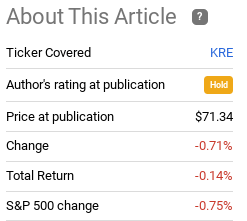
Fund Performance (Seeking Alpha)
With the markets seeing plenty of volatility so far in 2022, I wanted to take another look at KRE to see if I should change my rating. After review, I do believe a more bullish/buy rating is warranted for a few reasons. One, regional banks are attractively priced, as is the broader Financials sector, when we consider valuations compared to the broader market. Two, regional banks are less exposed to foreign revenue streams, which make it attractive in an environment where geo-political risks are dominating headlines. Three, the Fed’s rate hiking cycle, which is consistent with other central banks around the world, will provide a tailwind to lenders and financial institutions.
Why Consider Banks In This Climate?
To begin, I want to touch on a few key points as to why readers may want to consider banks/financial stocks more broadly. This is relevant to KRE, but also to the myriad other ways investors can play this space. The first is valuation. While most sectors are still sitting with forward P/Es above the five-year average (indicating stocks are a bit pricey), the Financials sector remains competitively priced. For comparison, note that Financials have a forward P/E lower than every other sector, with the exception of Energy:
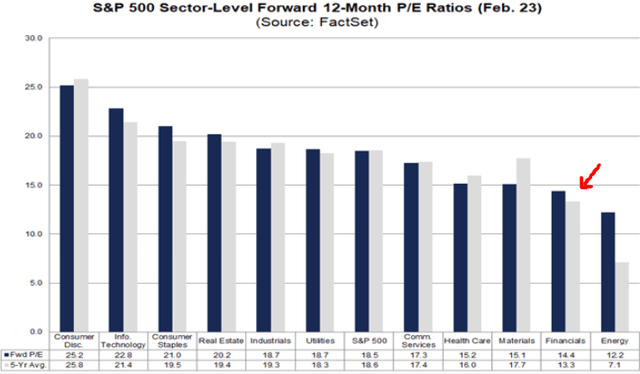
Sector P/E Ratios (Google Finance)
Of course, this doesn’t necessarily mean the sector will out-perform, or even produce a positive return. But it should give investors some comfort, given the wild ride we have been on recently.
Regional Banks Are Predominately US-Focused – The takeaway here is simple. Regional banks are less at-risk of a sell-off from geo-political events. Their fortunes are not tied to Europe, Russia, or any other region aside from the U.S., for the most part.
Growth Through Mergers
Another positive for the broader regional bank sector has been the strong uptick in mergers and acquisitions over the past few years.
KRE is a nice way to play this concept, since it holds companies that are very under-weight the S&P 500 (or not included at all). Further, while Fed rate hiking may be a headwind for the broader market, it should be a positive catalyst for KRE, and other banking funds.
- 04/07/2022 – interest rate hike could help regional bank profits, especially if the U.S. manages to avoid a yield inversion. Regional banks often are more rate-sensitive than their larger peers because they don’t have other businesses, such as trading desks, that are less connected to interest rates.
4 Regional Bank Stocks Rooting for More Rate Hikes
Rate-sensitive regional bank stocks could be among the top beneficiaries of the Fed’s hiking cycle, especially if the U.S. manages to avoid a yield inversion.
The Federal Reserve recently announced a much-anticipated hike in interest rates – a 25-basis-point uptick that’s expected to be just the first of several this year. The Fed’s hawkishness is largely expected to be a boon for the financial sector, including a wide swath of America’s regional bank stocks.
Bank stocks can, of course, enjoy a windfall from higher interest rates. The bank compensates the depositor at one interest rate, and then lends that money out at a slightly higher interest rate. The difference, or net interest margin, is an important source of revenue. (The risk, of course, is that too-high rates snuff out loan demand.)
And while some are worried about the possibility of a yield-curve inversion (where longer-term rates fall below shorter-term rates), Morgan Stanley Research Analyst Betsy Graseck says a shallow inversion shouldn’t noticeably weigh on the space.
“Banks generated positive loan growth in each of the 11 periods of (two-year/10-year) curve inversions since 1969,” she says, adding that she expects loan growth to accelerate from -2% in 2021 to roughly 7% in 2022, even if the curve inverts in line with her views.
Today, we’ll look at a group of companies that are more likely than other financial stocks to benefit from rising rates: Namely, regional bank stocks. Regional banks often are more rate-sensitive than their larger peers because they don’t have other businesses, such as trading desks, that are less connected to interest rates.
- 04/01/2022 – will the mother of all relief rallies turn back the growth of US economy and so is for DPST?
Tilson thinks there might be a mother of all relief rallies once Russia-Ukraine war ends
Finally, in yesterday’s e-mail I outlined one more reason why I think we could see a reversal toward growth stocks:
I have sources with contacts in the Ukrainian military who tell me that the headlines about demoralized and disorganized Russian forces taking big losses are, if anything, understated. This leads me to believe that the odds are higher than most people think of a ceasefire in the near future followed by a peace deal, which would likely lead to the mother of all relief rallies.
In such a rally, I think the most beaten-down (i.e., growth) stocks would jump the most.
- 03/21/2022 -With the US Federal Reserve (Fed) raising interest rates again, the environment for both financials and value may be turning more favorable, in our view. Financial and energy have the best positive correlation with rising interest rate
As Rates Rise, Financials Can Shine
Summary
- The pandemic forced central banks to slash rates and restart the quantitative easing measures first rolled out during the financial crisis.
- Near-zero interest rates in the United States and negative rates in Europe have compressed net interest income.
- After several years of strong markets and large volumes of equity and debt issuance, the US and European banks with significant capital markets businesses may struggle.
It has been a bumpy 2022 so far for the financials sector, and value stocks more broadly. As a major part of the value indexes, the sector’s performance can influence how the style performs. With the US Federal Reserve (Fed) raising interest rates again, the environment for both financials and value may be turning more favorable, in our view. After a lengthy period of historically low interest rates, rising rates can help boost earnings for financial companies, particularly for those that lend or invest their premiums in fixed income. Banks are also seeing a sharp pickup in loan demand, further supporting more positive industry fundamentals, and creating new opportunities in both the United States and Europe. The longer the war in Ukraine rages and energy prices remain high, however, the greater the potential for a sharp deceleration in global economic growth, which may abruptly end this tightening cycle.
Lower for (Not Much) Longer
For banks, as rates rise, they are generally able to boost the interest they charge on newly originated loans and existing loans with floating interest rates faster than they increase what they pay out on deposits. Loan origination is picking up, as people burn through the money they saved during the pandemic and companies borrow more amid the healthy economic environment. Eventually, higher rates will lead to higher deposit rates, but we believe it may take several hikes before banks feel any pressure from the pinch of higher funding costs.
For life insurers, rising rates mean they can invest their premium income at higher rates, improving the yield on their investment portfolios. Other areas of the sector that make money from interest-rate differentials may also see a profit benefit from higher rates. Author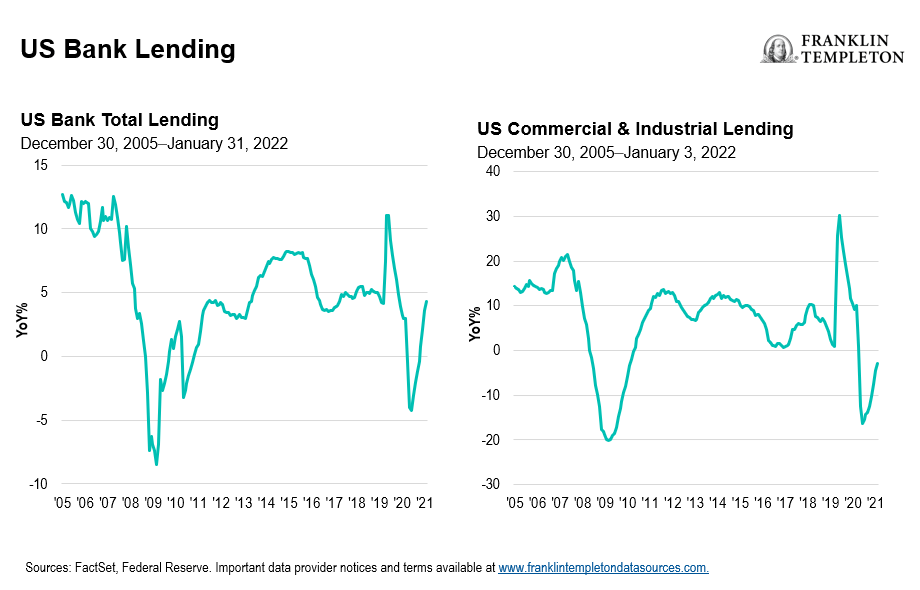
Location, Location, Location
Globally, we see clear valuation discrepancies between the United States and Europe. Europe remains behind the United States both in terms of economic recovery and when the first interest-rate increase might occur. Some US bank stock prices are already baking in a more favorable rate environment. We think large-cap US banks that have been improving their businesses offer some good opportunities for value investors.
In Europe, banks have become even cheaper following the Russian invasion of Ukraine and resulting weakness in the sector as investors assess the impact.
Among the large-cap banks, European valuations look more attractive to us than US valuations, mirroring a similar discrepancy between US and European equities more broadly. Our view continues to be that even a slightly less negative interest-rate environment in Europe should improve banks’ earnings outlook, and we expect the European Central Bank to eventually follow the Fed in raising rates. In addition to a more favorable fundamental backdrop, we see opportunities for several European banks to unlock value for shareholders by making their operations more efficient and selling assets.
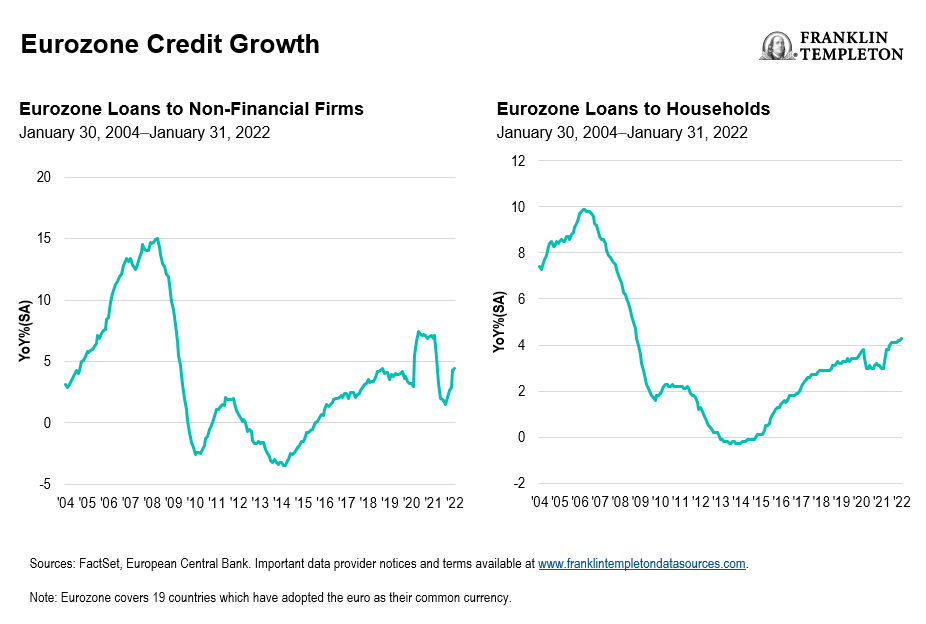
- 03/09/2022 – U.S. banks have little direct exposure to Russia, thanks to sanctions that were put in place on certain Russian businesses and oligarchs starting in 2014. Citigroup (C)—which derived about half of its $72 billion in revenue for 2021 from outside the U.S.—last week said it had roughly $10 billion in exposure to Russia and that it risks losing $4 billion due to that exposure. For most other U.S.-based banks, Russia isn’t even among the top 20 countries they do business with. In additions, three keys factors are in favor of banking stocks (interest rate, loan growth, expense)
U.S. Banks Are Facing Big Challenges. Here’s How to Play It
three keys things are needed to think about investment in banks
- interest rate
- growth of loan
- expenses, inflation, revenue growth
KBE is +7% this year so far, SP500 is down -7%
Although the banking sector is overall strong, banks around the world must now navigate a challenging geopolitical backdrop—as well as the Federal Reserve’s plans to raise interest rates in the U.S. Consider the SPDR S&P Bank ETF (ticker: KBE), which just a few weeks ago was up 7% for the year. Russia’s invasion of Ukraine roiling markets, the ETF is now down about 4%.
For investors, taking a stock-picking approach may make the most sense to determine which banks are best-equipped to handle significant issues.
But there’s some good news: U.S. banks have little direct exposure to Russia, thanks to sanctions that were put in place on certain Russian businesses and oligarchs starting in 2014. Citigroup (C)—which derived about half of its $72 billion in revenue for 2021 from outside the U.S.—last week said it had roughly $10 billion in exposure to Russia and that it risks losing $4 billion due to that exposure. For most other U.S.-based banks, Russia isn’t even among the top 20 countries they do business with.
- As markets approach the end of their second week of trading, investors will note that exchange traded fund capital flows have gone towards financials, energy, and the semiconductor space.
- The three funds that have attracted the most significant amount of capital in 2022 are the Financial Select Sector SPDR ETF (NYSEARCA:XLF), Energy Select Sector SPDR ETF (NYSEARCA:XLE), and the VanEck Vectors Semiconductor ETF (NASDAQ:SMH). All data below is per ETF.com.
- 06/24/2021 – Good for big banks and maybe bank industry overall – more dividend and buybacks
Fed Gives Big Banks Clean Bill of Health in Latest Stress Test – WSJ
Stress tests gauge banks’ ability to maintain strong capital levels and keep lending in a hypothetical severe recession
The Fed capped dividends and barred buybacks last summer, citing the need to conserve capital during the coronavirus-induced downturn. After an extra round of stress tests, it loosened some of those restrictions, saying dividends and buybacks couldn’t exceed profits from recent quarters.
Thursday’s actions end those limits. Analysts had anticipated that would lead to a jump in payouts when the banks start disclosing plans Monday afternoon.
Capital returned to investors over the coming year could approach $200 billion, Barclays analysts estimated. They now expect most banks’ payouts to shareholders to exceed their profits.
- 03/24/2021 – bank stocks might still be good in 2021 so far because economic recovery, 10-year treasury yield might increase to 2.1%, banks may exceed consensus 2021 earnings estimates
BofA Raises Bank Stock Price Targets, Sees Potential For ‘Significant EPS Upside’
Bank stocks are off to a hot start to 2021, and one analyst said Tuesday the early-year momentum will likely continue in the quarters ahead.
The Analyst: Bank of America analyst Erika Najarian raised her price target for U.S. bank stocks by an average of 11%. Here are several of her Buy-rated picks:
- JPMorgan Chase & Co. (NYSE: JPM), target raised from $163 to $181.
- Citigroup Inc (NYSE: C), target reiterated at $100.
- Wells Fargo & Co (NYSE: WFC), target raised from $39 to $43.
- M&T Bank Corporation (NYSE: MTB), target raised from $183 to $190.
The Thesis: Najarian said there are three primary reasons she is bullish on bank stocks:
- The economic recovery is rapidly gaining steam, and Bank of America is forecasting 6.5% U.S. GDP growth in 2021.
- Bank of America economists recently raised their year-end 2021 10-Year Treasury yield forecast to 2.1%.
- Recent conversations with banking industry insiders suggest banks may exceed consensus 2021 earnings estimates.
“If the economy does indeed heat up, >60% of bank loans are priced off the short end of the curve, creating significant EPS upside when the Fed decides to raise short rates,” Najarian wrote in a note.
She named Citigroup her top stock pick among large-cap bank stocks along with M&T and Fifth Third Bancorp (NYSE: FITB). Her top stock picks among small- and mid-cap banks stocks are East West Bancorp, Inc. (NASDAQ: EWBC), Signature Bank (NASDAQ: SBNY) and First Horizon Corp (Tennessee) (NYSE: FHN).
Benzinga’s Take: Banks will likely continue to deal with historically low interest rates weighing on net interest margins in 2021 and beyond. Yet bank balance sheets are far more healthy in 2021 than they were back in 2010 during the recovery from the last economic crisis.
- 03/24/2021 – Yellen supports banks’ share buybacks because their financial institutions look healthier now
Yellen supports banks’ share buybacks. Sen. Warren wants BlackRock designated too big to fail
- Treasury Secretary Janet Yellen gave her blessing to the Federal Reserve’s decisions late last year to allow banks to buy back their own shares again.
- The industry’s biggest names “look healthier now” after being held back from returning cash to shareholders during the Covid-19 pandemic, she said.
- Yellen faced harsh questioning on a related issue when Sen. Elizabeth Warren said she wants money management giant BlackRock to be regulated the same as Wall Street’s too-big-to-fail institutions.
Yellen, speaking Wednesday before the Senate Committee on Banking, Housing and Urban Affairs, said she agreed with allowing the share buybacks.
“I have been opposed earlier when we were very concerned about the situation the banks would face about stock buybacks,” Yellen said. “But financial institutions look healthier now, and I believe they should have some of the liberty provided by the rules to make returns to shareholders.”
- 03/03/2021 – Mr. Powell is due to speak Thursday at The Wall Street Journal Jobs Summit and some Fed watchers suspect he might address the exemption allowing banks to hold less capital compared with the size of their balance sheets is due to expire March 31, nearly a year after its adoption to facilitate the Federal Reserve response to the coronavirus pandemic. If capital relief is made permanent or extended, “banks can go ahead and buy more Treasurys,” If not, there will be a bank sell of on treasurys. – watch on 03/04
Bank Appetite for Bonds Fueled by Capital Holiday – WSJ
Some investors say a recovery from February’s Treasury rout is vulnerable to the rollback of an exemption that favors government-bond purchases
A special exemption allowing banks to hold less capital compared with the size of their balance sheets is due to expire March 31, nearly a year after its adoption to facilitate the Federal Reserve response to the coronavirus pandemic.
The exemption enables large banks to exclude their holdings of Treasurys and central bank reserves when working out how much capital they need to meet a standard known as the Supplementary Leverage Ratio. The banks will need more capital to hit the same ratio levels if the exemption is allowed to expire, a requirement they could meet by trimming their balance sheets—which often means selling Treasurys.
If capital relief is made permanent, “banks can go ahead and buy more Treasurys,” said Zoltan Pozsar, money-market strategist at Credit Suisse. If not, he added, they could do the opposite.
The exemption was created to help the Fed inject vast amounts of fresh money into capital markets, giving commercial banks a dispensation for the rapid growth in their balance sheets that is a byproduct of large-scale central bank bond-buying programs.
Both Citigroup Inc. and JPMorgan Chase & Co. called for the exemption to be made permanent or at least extended in fourth-quarter calls with investors.
Fed Chairman Jerome Powell was asked several times in last week’s congressional hearings whether this capital relief would be extended. He said only that the Fed was looking at it and had made no decision. Mr. Powell is due to speak Thursday at The Wall Street Journal Jobs Summit and some Fed watchers suspect he might address the exemption then.
- 03/02/2021 – rise in bond yields is good for banks, might still have more room to run this year
Regional Bank Stocks Rise as Bond Yields Climb – WSJ
Banks’ performance is reversal from dismal 2020 when they set aside billions to prepare for soured loans
Investors are living in a bond world. But bank stocks are enjoying a renaissance, too.
U.S. bond yields have risen at a fast clip. The yield on the 10 year Treasury rose to 1.459% in February, the largest one-month gain since 2016. The bond yield started February at 1.007%. That rise has also been good for bank stocks, since higher rates typically mean higher profits.
The KBW Nasdaq Bank Index is up 19% so far this year. The KBW Nasdaq Regional Banking Index is up 25%.
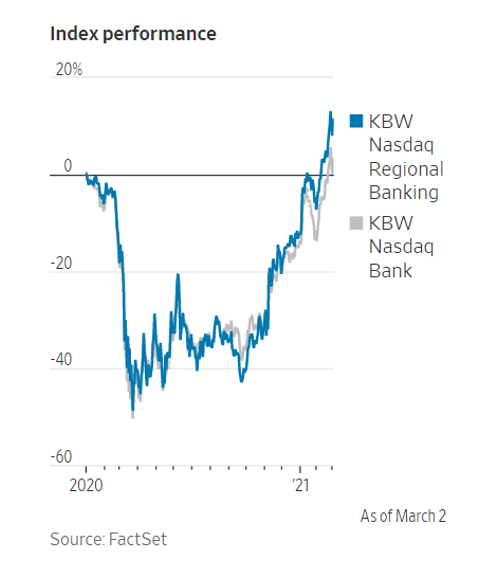
- 02/01/2021 – watch out when bank will make decision
Big banks await Fed decision on whether it extends a rule at the end of March
- A rule that the Fed imposed to promote liquidity and smooth functioning of the U.S. Treasury and funding markets is set to expire on March 31, 2021, and the decision on whether to extend it could have big implications for 14 large banks and for the U.S. Treasury markets. The interim rule excludes a bank’s UST and deposits at Federal Reserve Banks from the supplementary leverage ratio (“SLR”) calculation for banks.
- A group of Morgan Stanley strategists and equity analysts, including Kelcie Gerson and Betsy Graseck, expects the Fed to extend the rule since the SLR would likely become a binding constraint rather than the backstop constraint it’s been acting as.
- How will banks be affected if the rule isn’t extended? “With projected reserve growth and an increase in privately held UST issuance, SLR could very well become a binding constraint for some large banks in coming quarters,” the group writes.
- As a result, banks could move to turn away deposits, slow stock buybacks to hold onto capital, or issue preferred stock, all actions that would inhibit banks’ return on equity
- 01/16/2021 – more regulations will come for banking industry, this might hurt profit
An Old Foe of Banks Could Be Wall Street’s New Top Cop
Gary Gensler is expected to be Joe Biden’s pick to take over the Securities and Exchange Commission. ‘He will do things that are controversial.’
WASHINGTON—President-elect Joe Biden’s expected pick of Gary Gensler to lead the Securities and Exchange Commission could give Wall Street its most aggressive regulator in two decades.
The finance industry has thrived under the Trump administration’s light regulatory touch. Mr. Gensler, who sources familiar with the transition say is likely to be tapped by Mr. Biden for SEC chairman, has a history of shaking up the status quo. If he gets the assignment, he would be tasked with toughening regulation and enforcement of public companies and the finance industry.
- 01/14/2021 – negatives for banks: rising net charge-offs, credit quality deteriorating, mortgage levels to decline, job losses, personal income squeezed, low interest rates, difficult to make loans in such uncertain economy, bank index already increases by 34%, tougher regulation; positive for banks: stock buyback plans to be announced, economy to come back, interest rate might increase when inflation and economy is back, stimulus plan to come, infrastructure, green new deal?
Bank Earnings: Expect a Messy Quarter and a Peek at 2021
Lenders last year faced some of their most daunting challenges since the financial crisis
Net charge-offs are expected to rise in the fourth quarter from the third but remain far below historic highs, analysts said. Concerns over deteriorating credit quality ate into profits in 2020, when banks set aside billions of dollars to cover potential losses. Banks and analysts have lowered their loan-loss estimates since the pandemic’s early days, but those could rise again if the current jump in coronavirus cases further slows the economic recovery.
Banks are expected to announce plans for stock buybacks, one of the main ways they return capital to shareholders. The Federal Reserve stopped buybacks at big banks last year, a move to preserve capital in an unsettled economy, but said in December that banks could restart them with limitations.
mortgage levels are expected to decline in 2021. Rising coronavirus cases and job losses threaten to keep consumers at home and squeeze their income, which would likely weigh on credit-card spending and leave some customers unable to pay their bills.
Low interest rates, which crimp bank profits by limiting what banks can charge on loans, are also a challenge.
What’s more, making loans in such an uncertain economy could prove difficult, in part because lenders aren’t sure how to evaluate customers’ risk profiles after months of loan deferrals. Loan growth decelerated in the fourth quarter, falling by an annualized 3% from the previous quarter, according to analyst estimates. And businesses that socked away cash earlier in the pandemic won’t need loans.
bank Index jumps 34% from Oct to Dec 2020
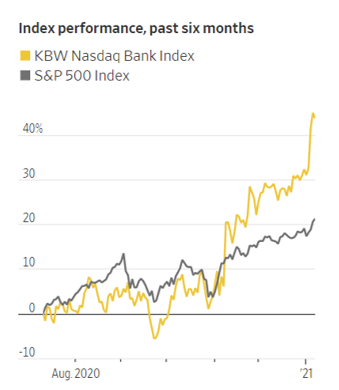
bank interest margin drops significantly due to low interest rate
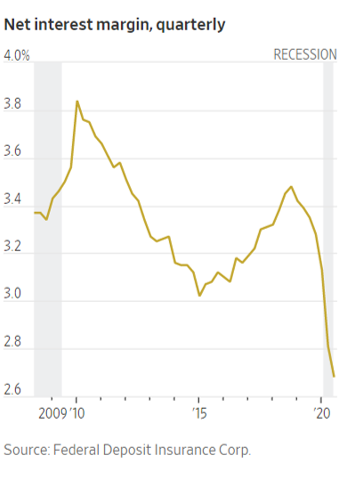
bank deposit becomes historically high
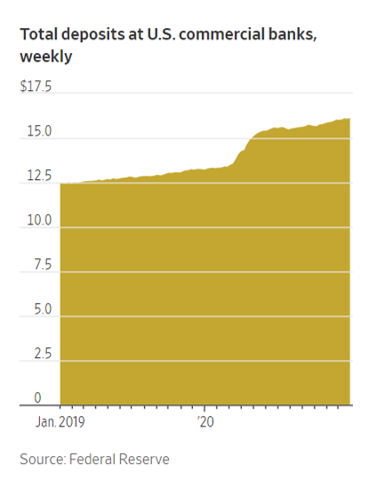
- 01/13/2021 – Q4 bank earning will come on this Friday. Watch out this Friday. watch out long term profit
2021 to be one of the ‘strongest’ bank earnings period ever seen: Dick Bove
Jan. 13, 2021 – 3:49 – Odeon Capital Group chief financial strategist Dick Bove discusses his outlook for bank earnings.
historical high reserve will be put into economic growth, earn more interest in loan. increase profit margin
buy JOM, BAC, WFC, hold C
- 01/12/2021 – Treasury yield climbs, it is good for financial stocks
10-year Treasury yield climbs to highest level since March
A similar rally in yields in 2013 was a ‘gift from the gods’
The U.S. 10-year Treasury yield rallied to a nearly 10-month high Tuesday as investors worried that stimulus measures to combat the economic slowdown caused by COVID-19 could unleash a wave of inflation down the road.
The benchmark 10-year yield climbed as many as 5.5 basis points Tuesday to a high of 1.187%, a level last seen on Mar. 19, the same day California became the first U.S. state to issue stay-at-home orders slowing the spread of COVID-19. The two-year yield, meanwhile, remained anchored near zero, touching 0.153%.
- 01/06/2021 – pay attention to change of interest rate
Markets will get plenty of notice before Fed cuts back on bond purchases, minutes show
- Federal Reserve officials agreed at their December meeting to make sure the public gets plenty of notice before the central bank’s bond purchases are reduced.
- Meeting minutes released Wednesday showed the Federal Open Market Committee was largely in agreement about the program.
- Markets were looking for whether some members were in favor of changing the program, but the minutes indicated little move in that direction.
- 01/06/2021 – increasing 10-year Treasury yield (since it has bottomed) and stock repurchasing might drive price even higher
Bank of America, Wells Fargo, Citigroup, and JPMorgan lead big gains for financials
Jan. 06, 2021 10:11 AM ETSPDR S&P Bank ETF (KBE)By: Stephen Alpher, SA News Editor42 Comments
The 10-year Treasury yield is up a big nine basis points to 1.048% following last night’s Georgia election which apparently has given control of the Senate to the Democrats. First-level thinking says that’s more fiscal stimulus going forward than otherwise, not to mention smaller details like assistance for strained big-city municipal budgets (think NYC transit, among other items) and restoration of the full SALT deduction.
A steeper yield curve is a boon to bank bottom lines, and in a roughly flat tape, the SPDR S&P Bank ETF (NYSEARCA:KBE) is gaining 5.5%. The SPDR S&P Regional Banking ETF (NYSEARCA:KRE) is ahead 6.4%.
Individual names: Bank of America (BAC +6.5%), Wells Fargo (WFC +6.7%), Citigroup (C +5.6%), JPMorgan (JPM +3.9%), PNC Financial (PNC +5.3%), U.S. Bancorp (USB +4.6%), Schwab (SCHW +5.1%), AmEx (AXP +3.8%).
- 12/18/2020 – bank buyback is coming, this is exactly why Buffett wants to have BAC as his second largest position. I forgot to buy more LEAPs of BAC, FAS and DPST. And I swapped FAS to GUSH and ERX, not sure the timing is right or not.
Fed allows banks to resume share buybacks, JPMorgan stock jumps 5%
PUBLISHED FRI, DEC 18 20204:33 PM ESTUPDATED FRI, DEC 18 20205:01 PM EST
- The Fed announced on Friday that it will allow the nation’s largest banks to resume share buybacks in the first quarter of 2021 subject to certain rules.
- The partial relaxation of its buyback ban came after the Fed’s second round of stress tests in 2020.
- JPMorgan Chase announced in the minutes after the Fed’s test results that its board had approved a new share repurchase program of $30 billion.
Fed Stress Tests Show U.S. Banks Can Withstand Covid-19 Pandemic
Banks are allowed to restart share buybacks, with limits, as central bank continues to cap dividends
The Federal Reserve said Friday that the largest U.S. banks remain strong enough to survive the coronavirus crisis but warned that a prolonged economic downturn could saddle them with hundreds of billions of dollars in losses on soured loans.
The Fed also said it would allow the banks to restart share buybacks but that it would, at least in the first quarter, restrict the amount. It said it would continue to restrict dividend payouts.
- 12/14/2020 – A large share of government relief for businesses and consumers ended up at community banks, boosting deposits and loans, fully offset the negative impact of reduced interest rate and pandemic crisis. Good for small banks.
‘The Best Year Ever’: 2020 Was Surprisingly Good to Small Banks
A large share of government relief for businesses and consumers ended up at community banks, boosting deposits and loans
As 2020 draws to a close, small lenders like Rosedale are doing far better than expected at the outset of the coronavirus recession—largely thanks to government money that passed through banks on the way to households and businesses. Stimulus and unemployment checks boosted deposits and kept borrowers from falling behind on their loans. The Paycheck Protection Program—the government’s small-business bailout—brought them new customers and kept old ones afloat.
Profit at community banks—small, local lenders—jumped 10% in the third quarter from the same time last year, according to the Federal Deposit Insurance Corp. Total loans rose 13.4% in the third quarter, compared with 4.9% for the industry. Deposits surged 16.7%. Noncurrent loan rates have risen slightly this year but are still far below levels seen during the last financial crisis.
Small lenders have long struggled to compete with their bigger rivals. They lack the trading desks and deal-making businesses that buttress megabanks when low interest rates crimp lending profitability. And consumers have come to rely on the smartphone apps and digital services that many small banks can’t afford to offer. Technology costs and wafer-thin lending margins have prompted many smaller banks to consolidate.
“PPP was a tremendous shock in terms of balance sheet growth, earnings and liquidity,” said Sandy Brown, an attorney at Alston & Bird LLP who counsels community banks.


- 12/03/2020 – the possibility of release biggest reserves in the 2nd half of 2021 can become a big catalyst for bank stocks. Watch out the stress test results which will come near of end of year 2020. I have sold some LEAP due to upcoming expiration. And I might need to roll over to longer term LEAP.
Banks could see a windfall as economy recovers: ‘Biggest reserve release in the history of banking’
Banks have been among the most hated of stocks since the pandemic struck this year, forcing lenders to put up tens of billions of dollars in preparation for an expected tsunami of bad loans. Now a silver lining is emerging.
The four biggest U.S. banks – JPMorgan Chase, Bank of America, Citigroup and Wells Fargo – have amassed a nearly $100 billion pile of cash for loan loss reserves as of the third quarter. The broader industry has created its largest collective reserve since 2010, when mortgage defaults sparked a recession that required massive bailouts of banks and other companies.
But the story may end differently this time. A combination of factors – promising vaccines that should enable a U.S. economic reopening, surprisingly resilient bank customers and the expectation that lawmakers will approve another round of stimulus – should allow banks to begin releasing reserves in the second half of 2021, according to five bank analysts surveyed by CNBC.
- 11/29/2020 – be cautious with bank stocks
Bank stock rally is vulnerable with a weak jobs report in view: Sector Watch
Bank stocks have been on a tear during the vaccine-inspired recovery rally. But continued momentum still depends on a steepening of the yield curve.
The market will get a good indicator of whether rates can break out of their range with the November employment report on Friday. The latest gauge on jobs will reflect the recent spike in COVID cases, which has put pressure back on small businesses as state and local authorities resumed stricter lockdown measures.
Economists, on average, are looking for nonfarm payrolls to rise by 500K this month, with the unemployment rate ticking down to 6.8% from 6.9%.
That would be the fifth-straight month of declining payrolls growth and leave the economy about 9M jobs away from the levels before the plunges in March and April.
And there are concerns that the economy could be close to shedding jobs for the first time in this recovery.
Last week, weekly jobless claims edged higher for the second week, as 1.1M people filed for benefits if you add in Pandemic Unemployment Assistance.
That “was the 36th straight week total initial claims were greater than the worst week of the Great Recession,” the Economic Policy Institute noted.
Looking at the claims and employment data that is tracked by Homebase and Kronos as predictors, they are consistent with a seasonally-adjusted decline in payrolls of nearly 400K, economist Ernie Tedeschi tweets.
A surprise drop in payrolls would be a huge blow to yields, which have found themselves stifled again after a surge following Pfizer first announcing its vaccine efficacy date.
The 10-year Treasury yield challenged the important 1% level shortly after the Pfizer news, but was quickly knocked back. It now sits at 0.84%, having been penned in between 0.9% and 0.8%.
To move past 1%, the Treasury market needs economic data to provide a consistent boost, with the specter of QE from the Fed pushing rates down keeping bonds from experiencing a meaningful selloff.
But investors should remember “the Fed looks at Treasuries as part of a bigger equation of financial consideration,” Jim Caron, Morgan Stanley fixed income portfolio manager, says.
“If equities are doing well and if the unemployment rate is falling fast enough, then the Fed is perfectly happy to allow Treasury yields to rise to 1.25%, 1.45%,” Caron told Bloomberg.
“If that’s not happening, the Fed would exert their pressure to lower yields.”
The minutes of the last FOMC meeting indicated members were considering shifting the pace of asset purchases or moving further down the curve.This past week, Wells Fargo boosted its forecast for the 10-year yield next year by 25 basis points to 1% to 1.5%.
The SPDR S&P Bank ETF (NYSEARCA:KBE) is up nearly 19% since the recovery rally began this month. It’s up 20.5% for the whole month.
- 11/29/2020 – is buyback of bank share coming?
Bank Of America: December CCAR And The Buybacks Catalyst
- The Fed is about to release the “pandemic-induced” mid-cycle CCAR stress tests.
- BAC should easily pass the CCAR stress tests and with flying colours.
- The opportunity for BAC is massive return of excess capital in the next 2-3 years.
- BAC is a compelling buying opportunity for long-term investors who can afford to be patient.
- In the interim, I am looking forward to dividend increases and large buybacks in tow.
The “pandemic-induced” mid-cycle CCAR is due to be published in December 2020. It is a makeshift effort designed to deal with the unusual circumstances of COVID-19 manifesting through the global economy.
- 11/24/2020 – The pick of Yellen might mean we will low interest rate as long as possible. May not be good for financial banks
A Fed Chair for Treasury
Yellen is likely to exert considerable influence over the central bank.
Ms. Yellen is an economist by training but she’s a political economist by experience. Most recently she was Chair of the Federal Reserve during President Obama’s second term. But she has also done stints as president of the San Francisco Fed and the White House Council of Economic Advisers. That’s a gold-plated political resume, and she has a reputation for always knowing her brief.
She trained under economist James Tobin at Yale and throughout her long career she has followed the Tobin precepts of easy money, with generous social spending financed by tax increases. She believes in the Keynesian precept that federal spending spurs economic growth—the kind of spending matters less than the amount—and in recent months has called for much more in federal Covid-19 relief. This no doubt appeals to Mr. Biden, who is fond of the Obama spending spree of 2009-2010, and it will certainly make Ms. Yellen a popular choice among Democrats on Capitol Hill.
In 2014, three months into her four-year tenure chairing the Federal Reserve, Janet Yellen was trying to draw an important link for investors, policy makers and community development leaders.
“Although we work through financial markets, our goal is to help Main Street, not Wall Street. By keeping interest rates low, we are trying to make homes more affordable and revive the housing market. We are trying to make it cheaper for businesses to build, expand, and hire,” Yellen said in remarks at a conference in Chicago.
“She’ll be very responsible, but at the same time, she will go out there to bat for people at the lower end of the spectrum. She’ll be very sensitive to their problems,” he said.
Here’s a look at what experts say a Yellen-led Treasury Department will mean for another round of government stimulus, taxes in a Biden administration and student-debt cancellation.
- 11/18/2020 – some catalysts have played out for mid-cap bank stocks: a “positive feedback loop” (“the resolution of the U.S. election, and positive vaccine news from a pair of companies, improving economy, steeper yield curve, reduced policy risk, and potential pickup in M&A?”). Question for myself: Should I start to look for commercial real estate exposure in New York City?
BofA sees more upside in names despite regional bank rally
A rally in regional banks isn’t tamping down BofA enthusiasm for the sector, as it sees a case for more room for re-rating the stocks as macro conditions improve.
A 45% rebound off September lows reflects how some catalysts have played out for mid-cap bank stocks, the firm says, including the resolution of the U.S. election, and positive vaccine news from a pair of companies. And that suggests a continuing broad-based rally will need a “positive feedback loop” (“improving economy, steeper yield curve, reduced policy risk, and potential pickup in M&A?”).
But BofA is hearing increased investor appetite for more bank exposure – and together with outperformance by the Russell 2000 (outperforming the S&P 500 by 1,000 basis points quarter-to-date) makes for a tailwind for regional banks.
What’s the appropriate valuation for stocks against a zero-bound interest rate and assuming no credit hiccups? BofA thinks mid-cap banks should deliver 10-12% return on tangible common equity.
That leads it to a pair of names: Signature Bank (NASDAQ:SBNY) has jumped 46% after the vaccine news and bullish growth commentary from management, but the stock trades to 1.2x price/total book value and 9.4x price/earnings, vs. a comparable from high-growth peers of more than 2x price/total book value and more than 20 P/E.
That’s a discount reflecting credit concerns over the bank’s commercial real estate exposure in New York City, but BofA cites two catalysts on the credit front: increased clarity as loans on their second deferral come to the end of their deferral term (BofA expects the “vast majority” to return to paying status); and a gradual reopening of the NYC economy in the first half would go a “long way” toward reversing “overdone” negative investor sentiment.
“In addition to the strong growth profile, SBNY’s commercially focused, branchless business model is well suited to thrive in a banking landscape that is being transformed by accelerating digital adoption by its customers,” BofA says, adding that efficiency ratio under 40%, double-digit balance sheet growth and relatively resilient net interest margin should lead to upside. It has a $150 price target, implying 37% upside.
Investors have gotten more cautious on SVB Financial (NASDAQ:SIVB) particularly due to valuation premium: The stock is up 41% year-to-date, vs. a 16% decline in the regional bank index. But the stock can re-rate further, it says.
It recommends maintaining exposure due to a best-in-class growth model (“part luck, part execution, SIVB finds itself serving what is arguably the best growth sectors in the U.S. economy”); best-in-class execution (heavily improved balance sheet management and ability to offer guidance to investors); and a unique source of growth capital (through its own equity gains; SIVB has been able to self-fund balance sheet growth without having to tap equity markets).
There’s a possible downside scenario where a sell-off in tech/healthcare partly reverses the YTD outperformance in SIVB, but that shouldn’t meaningfully alter management’s ability to get new clients – and any sustained economic improvement likely brings a steepening yield curve and SIVB benefiting from near-zero funding costs.
On SVB, it has a Buy rating and $390 price objective, implying 12% further upside.
- 11/13/2020 – watch out what Biden admin will do with the banks. GOP senate might limit his ambition
Biden Transition Chief Proposed Limiting Size of Biggest U.S. Banks
Ted Kaufman, former chief of staff to the president-elect, will have a voice in choosing financial regulators
At the time, Democrats were crafting the Dodd-Frank Act to tighten regulation of banks after the global financial crisis. Mr. Kaufman sponsored an amendment to prohibit any bank from holding more than 10% of the country’s deposits. Had it passed, the amendment would have forced the biggest firms to break up.
Mr. Biden has also embraced a proposal to offer banking services through the post office to underserved people and to create a government-run credit-reporting company to ensure against discrimination in credit reports. And he has signaled a willingness to consider a tax on large financial institutions, though a similar effort in the Obama administration failed to gain traction.
- 11/10/2020 – Fed website to look for 10 year treasury yield. Bank stocks are closely related to 10 year treasury yield, which is at histrical low.
- 11/10/2020 – tailwind for banks: vaccine comes, economy grows, bond yields rose, providing a benefit to banks’ net interest margins; headwind: long-term yields still remain historically low and increased regulation. Nevertheless, The sector lags behind the broader S&P 500 by roughly 30% and valuations remain “compelling” compared with pre-pandemic levels
Bank Stocks Still Have Room to Run Even With Challenges, Analyst Says
Bank stocks may have had a significant run-up in recent days, but the sector may still represent compelling opportunities for investors.
The sector had double-digit gains in Monday’s trading on the heels of positive Covid-19 vaccine data as investors hoped that the rollout of an effective vaccine would speed up the economic recovery and provide support to struggling bank stocks. Rising bond yields on Monday’s news also helped lift bank stocks.
But even with the gains—the KBW Bank Index (ticker: BKX) and the KBW Regional Banking Index (KRX) rose 13% and 16%, respectively on Monday—analysts still see opportunities for banks. The sector lags behind the broader S&P 500 by roughly 30% and valuations remain “compelling” compared with pre-pandemic levels, Frederick Cannon, director of research at Keefe, Bruyette & Woods, wrote in a recent note.
But while there are opportunities, that’s not to say it will be an easy ride for banks. The sector is still operating amid ultralow interest rates and facing the prospect of increased regulation under a Biden administration.
“We do not expect a straight line up for financial stocks, and caution that challenges remain, including still low interest rates and increased regulation,” Cannon wrote. To be sure, absent a blue wave in last week’s election, few expect sweeping regulatory changes for banks.
“We do not expect a straight line up for financial stocks, and caution that challenges remain, including still low interest rates and increased regulation,” Cannon wrote. To be sure, absent a blue wave in last week’s election, few expect sweeping regulatory changes for banks.
While bond yields rose, providing a benefit to banks’ net interest margins, long-term yields still remain historically low, meaning that banks will continue to feel some pressure. That said, a rise of 2 basis points in net interest margins would improve bank earnings per share by 1.9% in 2022, according to Vivek Juneja, analyst at J.P. Morgan Chase. He expects that banks that have a high share of long-dated residential mortgage loans, like Bank of America (BAC), Wells Fargo (WFC), and U.S. Bancorp (USB), would benefit most.
- 11/09/2020 – 10-year Treasury yield climbed most in single day since March. This causes the bank share to jump.
High-Yield Bonds Are Surging While Treasuries Slump on Vaccine News. What’s Going on.
Treasuries sold off and high-yield bonds rallied after Pfizer and partner BioNTech released promising news about their coronavirus vaccine trial.
Long-term Treasury yields climbed most, with the benchmark 10-year yield up 11 basis points, or hundredths of a percentage point, to 0.93%. If the move holds, it will be the biggest single-day increase in yields since the Treasury market’s liquidity crisis in March, according to Bloomberg data.
Low yields have made the Treasury market less popular as a haven in recent months. In recent weeks, the prospect of economic improvement and potential stimulus has increased investors’ expectations for a recovery in growth and inflation. Monday’s vaccine news stoked further optimism.
- 11/08/2020 – Tilson and Kass are correct. Bond yield might rise steadily. Bank share will increase. This is exactly what happens today.
Doug Kass remains bullish on bank stocks;
Trade of the Week (Long XLF $23.86)
The stars, fundamentals, “the pivot” (from growth to value), bond prices, and charts might now be aligning to produce a strong short term rally in bank stocks
The case for a near term rally in bank stocks may (finally!) be improving:
* Fundamentals: As expressed below, third-quarter EPS results indicated that despite record low interest rates (margins and net interest income) and unprecedented loan loss provisioning, the major money center banks have scaled a lot of their profit headwinds and will still likely record an expansion in tangible book value in 2020 over 2019. Investors should now begin to focus on the “easy credit compares” and nadir of net interest spreads next year.
* Bond Prices Are Firming: Bond yields are approaching the highest level since June. Bank stocks are the most asset sensitive sector and directly benefit from rising fixed income yields.
* The Charts May Be Aligned: Surprisingly to many the relative performance of banks stocks has been flat since July. Look closely and a breakout to the upside (of the BKX) could be at hand:
Source: The Divine Ms M
Moreover, on Thursday, in “Have The Charts of Financials Begun to Turn More Favorable?,” I pointed out that the chart of JPMorgan Chase (JPM) and other banks looked deeply oversold and similar to the favorable set up of a year ago – right before the group had a strong absolute and relative move higher:
However, this time, the relative strength line has been OK.
* The Pivot From Growth to Value May Finally Be At Hand: Banks are value stocks and should be a prime beneficiary of the pivot.
Bottom Line
Despite the near-universal hatred towards the group, the relative earnings momentum of banks (against the non-financial components of the S&P 500 Index) will begin improving materially in the quarters ahead. That positive momentum and change in the rate of growth will accelerate as 2021 progresses.
Not content with my already large financial holdings, I have recently added to my four money center bank positions, and established a new position in Goldman Sachs (GS).
Finally, let’s remember that in a market dominated by products and strategies that chase price and momentum (“buyers live higher”), should bank stocks make a move higher from here, the machines and algos will be following and buying bank stocks, post haste.
And the same cabal that is bearish on banks will then turn positive on banks.
- 11/04/2020 – the drop of yield might cause financial stocks drop significantly even though DOW is up by 1.34%
U.S. Treasury Yields Fall on Reduced Stimulus Expectations
Smaller economic stimulus seen as election returns suggest good chance that GOP will keep control of the Senate
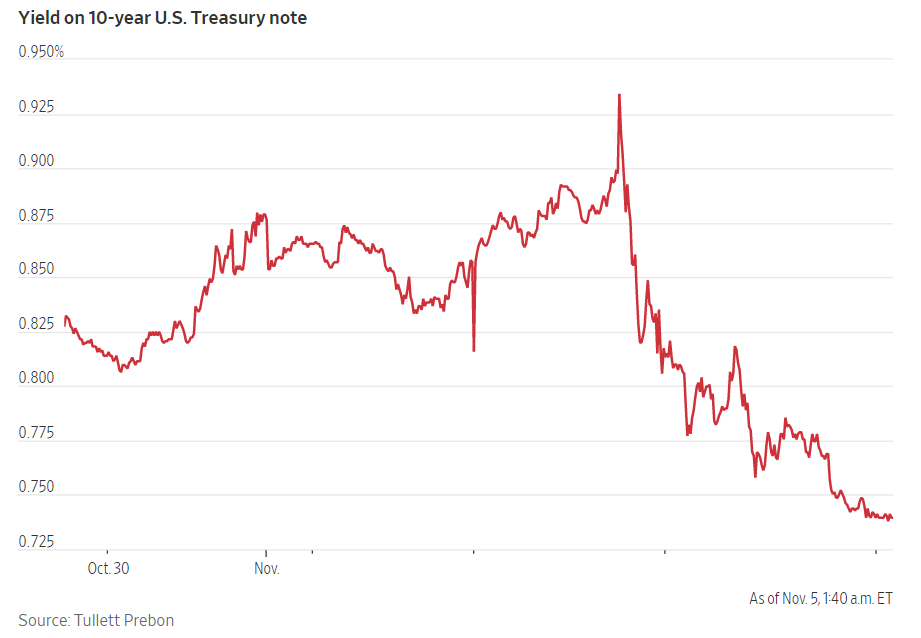
Investors preparing for a Democratic sweep had anticipated not only trillions of dollars in additional coronavirus aid but also more spending on renewable energy and infrastructure projects—enough, potentially, to at least increase the threat of higher interest rates and drive the 10-year yield to 1% or higher. The prospects for that result appeared dim on Wednesday.
“It seems like Joe Biden still has a potential path to the presidency but Democrats do not any longer have a path to win the Senate,” said Michael Lorizio, a senior trader at Manulife Investment Management.
That, he said should “result in a smaller fiscal package” and ensure that the Fed keeps interest rates near zero for even longer than previously expected.
Despite their declines, Treasury yields remain above their lows from the summer, when the 10-year yield fell below 0.6%. Analysts said that reflected expectations that Congress will still pass some kind of coronavirus aid as well as a recent run of decent economic data.
- 10/25/2020 – commercial property loans default might impact banks
Banks may have to brace for heavy losses as commercial property prices plunge
- In previous downturns, commercial property loan losses were “heavy” and there are worrying signs that such a trend could be repeated this time during the pandemic-induced slowdown, Oxford Economics’ Adam Slater said in a report.
- During the 2008 great financial crisis, for example, such loan losses accounted for between 25% and 30% of total loan write-offs in the U.S.
- “Large (commercial real estate) price declines generally translate into big losses for banks,” Slater, an economist at the firm, wrote.
- This time those risks look highest in the U.S., Australia, and parts of Asia such as Hong Kong and South Korea.
- 10/05/2020 – Bank’s earnings are coming, expected to be lower
The Big Banks’ Earnings Are Coming. Here’s What to Expect.
Earnings are expected to drop compared with last year’s as banks contend with a sluggish, but improving, economy. Low interest rates, expected to remain at rock-bottom levels, continue to weigh on net interest income
- 08/20/2020 – might be good for bank to cut cost and increase profit and becomes leaner and stronger
Banks eye layoffs as short-term crisis ends, long-term costs emerge
NEW YORK (Reuters) – At the height of the coronavirus pandemic last spring, the heads of U.S. banks including Morgan Stanley, Bank of America Corp and others pledged not to cut any jobs in 2020 because it was the wrong thing to do.
However, as executives prepare for an extended recession and loan losses that come with it, layoffs are back on the table, said consultants, industry insiders and compensation analysts.
Compared with April projections, bank economists and executives expect the U.S. economy to take longer to recover, with high unemployment into 2021 and interest rates staying near zero for the foreseeable future.
On top of that, working from home has shown some managers that they need fewer employees to do the same amount of work.
“No question, layoffs (will) come across the board for all the banks,” said Barry Schwartz, chief investment officer at Toronto-based Baskin Wealth Management, which invests in JPMorgan Chase and other large Canadian banks.
Banks have to cut costs because of expected credit issues, as well as low interest rates and regulatory pressure to trim dividends, he said.
- 08/19/2020 – challenge on banks remains
The Latest Pain Trade on Wall Street: Banks
Hedge funds that invest in banks are posting double-digit losses, and some are shutting down
The KBW Nasdaq Bank Index has fallen 33.1% this year; the S&P 500 is up 6.2%, including dividends. Regulatory filings Friday showed Warren Buffett’s Berkshire Hathaway Inc. sold out of billions of dollars of bank stocks in the second quarter, though it added to its Bank of America Corp. stake.
The ranks of financial funds have thinned due to fund closures during the financial crisis and waning investor appetite tied to low rates and sometimes-volatile returns. The recent issues with banks are putting more pressure on those investors that remain.
“Looking at financials funds and other sector funds, there’s so much more going on in biotech and in technology and there’s so little going on in financials at the moment that looks exciting, that more capital is moving away from financials,” said Kieran Cavanna of Old Farm Partners, a New York firm that invests and advises on roughly $275 million of client money in hedge funds.
The funds’ pain this year largely reflects tumbling profits for banks and uncertainty about many banks’ outstanding loans in the pandemic.
- 08/14/2020 – Buffett sold WFC and JPM, he is quite picky on individual bank stock
Warren Buffett sheds big stakes in banks and goes for the gold
Legendary investor reduces Wells Fargo, JP Morgan holdings and takes a shine to gold
Berkshire sold 85.6 million shares of Wells Fargo, representing about 26% of its stake and putting its ownership to about 3% from 5.3%.
The insurance conglomerate also shed 35.5 million shares of JPMorgan, 61% of its position, which now represents 1% of Berkshire’s overall portfolio from 3% in the prior period.
- 08/12/2020 – watch out the bankruptcies which might hurt bank profit
U.S. bankruptcies on track for 10-year high with more than 100 consumer companies already filing
U.S. bankruptcies are en route to a 10-year high with 424 companies filing as of August 9, according to S&P Global Market Intelligence. The group’s analysis took into account both public and private companies with public debt. The coronavirus has hit consumer companies hard, with more than 100 filing for bankruptcy including Men’s Wearhouse parent Tailored Brands Inc. TLRD, -17.67%, department store Lord & Taylor and work wear retailer Brooks Brothers. Nearly 100 bankruptcies are in the energy and industrials sector. Oil-and-gas producer Chesapeake Energy Corp. CHKAQ, 3.97% and small-engine maker Briggs & Stratton Corp. are among the 35 companies that have filed with more than $1 billion in liabilities. The Consumer Discretionary Select Sector SPDR ETF XLY, 1.33% has gained 13.3% for the year to date while the S&P 500 index SPX, 1.40% is up 4% and the Dow Jones Industrial Average DJIA, 1.05% has lost 2.6%.
- 07/31/2020 – The banks were trading at a median price-to-book value of about 84% in the quarter, down from 118% a year ago, Mr. Cassidy said. He is forecasting bank stocks will return to 110% of their book value.
Coronavirus Is the Crisis Some Bank Investors Have Been Waiting For
Bank results and stocks are getting hammered. But some investors see proof they are good investments.
Profits at U.S. banks are tumbling, their stocks are underperforming and their executives sound grim. Their long-term investors are thrilled.
Value investors seek underappreciated companies, and they have spent a decade betting that the banks are stronger than they were going into the 2008 financial crisis. The market hasn’t agreed. While bank share prices were rallying through last year, sometimes hitting record highs, they were broadly unloved.
Compared with the overall market, bank stocks have traded at lower multiples of earnings and value since the financial crisis. They have been punished as if investors expect any economic trouble to expose underlying problems.
The solution, some investors believed, would be a new crisis to prove the banks can survive, in a more convincing fashion than annual practice stress tests have.
At the same time, industries exposed to general economic growth, including banks and industrial companies, have been crushed. It is harder to judge the earnings power of those types of companies until investors get more clarity on the economy.
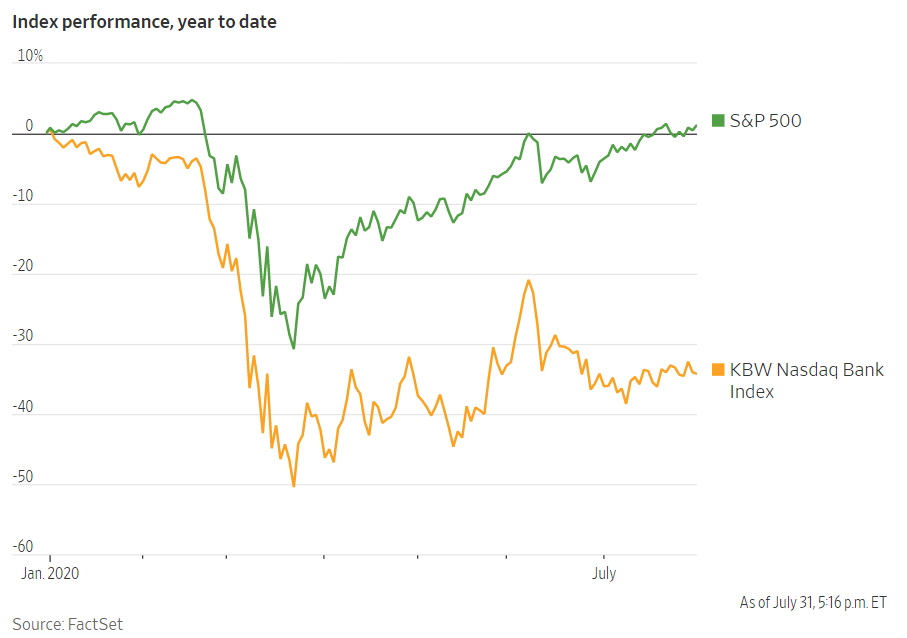
Those betting on banks have a different view: The banks, and particularly the big ones, have piled up so much capital and expanded their already-dominant positions since the last crisis that they are more immune to an economic collapse than before. These investors expect some pain but they think the market has overreacted, especially since they believe bank stocks were already undervalued before the coronavirus.
Eric Hagemann, an analyst at Pzena Investment Management Inc., said the results show the banks are increasingly able to handle potential loan losses.
“Should the banks demonstrate such resilience, that could lead to a structural rerating of the stocks as they begin to be treated more like ‘normal’ companies,” he said. “They haven’t been treated like normal companies since the great financial crisis.”
Other evidence showed the underlying value of bank assets increased in the second quarter. The average book value per share was up 7.4% from a year earlier, said RBC Capital Markets analyst Gerard Cassidy.
That important metric is one the bank bulls say is evidence the stocks could rally if there is more clarity about the economy and the virus.
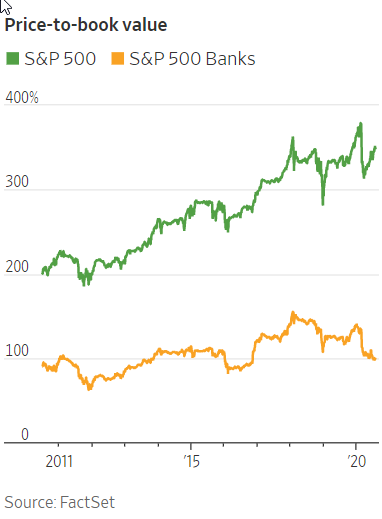
- 07/26/2020 – election risk for financial industry: financial regulation will weigh on financial stocks unless there is signal that a Biden administration will be led by centrists rather than progressives.
Here’s how a Biden presidency could hurt financial stocks
‘We expect that financial stocks will sell off later this summer if it looks like a Biden win is likely,’ KBW analyst Brian Gardner says
Here’s how the landscape could change for various parts of the financial industry.
- • Payday lenders: Biden would have the authority to put in place a new Consumer Financial Protection Bureau director, and Height’s Groshans expects the new boss would “roll back the proposed revisions to payday lending rule in a manner that eliminates the product completely,” saying it could be “terminated within three years.”
- • Student loans: Biden is aiming to eliminate tuition fees for community colleges and job training programs tuition, as well as make public colleges and universities free for families earning under $125,000 a year. Such moves “would reduce education loan originations, potentially materially, and servicing books and federal education loan investment portfolios would shrink as the current books amortize,” Groshans said in a note on Monday.
- • Credit bureaus: Biden has proposed having the CFPB create a public competitor to the credit reporting agencies, and that “would be negative” for Equifax, Experian and TransUnion, Groshans wrote.
- • Other consumer-focused financial companies: “The Biden campaign has promised to ‘reinvigorate’ the CFPB, so we expect a new wave of investigations will be aimed at student loan servicers, mortgage servicers, credit card companies, payday lenders, installment lenders, debt collectors, and credit-reporting agencies,” said KBW’s Gardner.
- • Banks: “Commercial banks were among the industries that benefited the most from the Trump administration’s regulatory agenda and banking regulation is likely to shift in a Biden administration, but maybe not as dramatically or as quickly as some investors think,” Gardner wrote. “The composition of the Federal Reserve Board (the most consequential banking regulator) will remain mostly the same until 2022, when Chairman Jerome Powell’s term expires.”
- • Investment banks and brokers: A Biden administration is likely to increase scrutiny of mergers and acquisitions by being more aggressive in antitrust reviews, which “could be an overhang for the M&A advisers,” Gardner said. In addition, the Labor Department “might scrap the latest proposal for a fiduciary rule and try to return to a version similar to what the Obama administration implemented in 2016.”
- • Exchanges: “The Biden administration has proposed a financial transaction tax (FTT) which we view as a negative for the exchanges,” Gardner said. “Normally, we would dismiss the idea of Congress’s passing an FTT, but in a COVID world where the government is searching for revenue to pay for the response to the pandemic, we cannot rule out the possibility that Congress will pass an FTT.”
- 07/20/2020 – be cautious optimistic on this: forbearance in total loans is decreasing (even though now CV rate is spiking); there is sharp increase in serious delinquencies in June.
from calculatedrisk.com, Note: To put these numbers in perspective, the MBA notes “For the week of March 2, only 0.25% of all loans were in forbearance.”
From the MBA: Share of Mortgage Loans in Forbearance Decreases for Fifth Straight Week to 7.80%
The Mortgage Bankers Association’s (MBA) latest Forbearance and Call Volume Survey revealed that the total number of loans now in forbearance decreased by 38 basis points from 8.18% of servicers’ portfolio volume in the prior week to 7.80% as of July 12, 2020. According to MBA’s estimate, 3.9 million homeowners are in forbearance plans.
…
“The share of loans in forbearance dropped to its lowest level in over two months, driven by an increase in the pace of exits as more homeowners have been able to get back to work,” said Mike Fratantoni, MBA’s Senior Vice President and Chief Economist. “The decline in the forbearance share was broad based, with decreases for GSE, Ginnie Mae, and portfolio/PLS loans.”Added Fratantoni, “Almost half of borrowers remaining in forbearance are now in an extension of the original term, while the remainder are in their initial forbearance plan. The pace of new forbearance requests remains quite low compared to earlier in the crisis, but we are watching carefully for any increases due to either the pick-up in COVID-19 cases or the cessation of enhanced unemployment insurance benefits at the end of this month.”
emphasis added
Click on graph for larger image.
This graph shows the percent of portfolio in forbearance by investor type over time. Most of the increase was in late March and early April, and has been trending down for the last five weeks.
The MBA notes: “Total weekly forbearance requests as a percent of servicing portfolio volume (#) remained flat relative to the prior week at 0.13%. ”
CR: Note that Lawler is discussing the sharp increase in serious delinquencies in June according to the Early Warning System. This means people have missed three payments (although many of these people are probably in forbearance programs.)
While the FHA’s “official” monthly loan performance report for June is not yet available on its website, data from the FHA’s Early Warning System indicates that FHA’s Early Warning System indicate that the serious delinquency rate on FHA-insured single-family loans surged in June.
Delinquency rates in the EWS do not match those in the official report, but the two delinquency rates tend to move together over time.
| Delinquency Rate, FHA-Insured SF Loans | ||||
|---|---|---|---|---|
| Official Report | ||||
| Total | 30-day | 60-day | SDQ | |
| 2/29/2020 | 10.85% | 5.16% | 1.65% | 4.04% |
| 3/31/2020 | 11.17% | 5.59% | 1.61% | 3.97% |
| 4/30/2020 | 15.52% | 9.20% | 2.28% | 4.04% |
| 5/31/2020 | 17.27% | 6.37% | 5.99% | 4.91% |
| Early Warning System, Active Servicers | ||||
| 2/29/2020 | 10.63% | 5.16% | 1.66% | 3.81% |
| 3/31/2020 | 10.74% | 5.36% | 1.62% | 3.76% |
| 4/30/2020 | 15.32% | 9.17% | 2.27% | 3.88% |
| 5/31/2020 | 17.15% | 6.37% | 5.99% | 4.80% |
| 6/30/2020 | 17.17% | 4.65% | 3.70% | 8.82% |
- 07/18/2020 – worst-case scenario is the virus surges further in the fall, forcing another round of widespread shutdowns, unemployment could peak at roughly 23%. Good-case scenario happens, JPMorgan is largely done setting aside cash for defaults. In that event, it could begin to repurchase billions of dollars in its stock again, perhaps as early as the fourth quarter. But in the most dire scenarios, JPMorgan could be forced to cut its 90 cent quarterly dividend to preserve capital.
Jamie Dimon’s warning for the U.S. economy — nobody knows what comes next
- The range of outcomes for the economy in the second half is incredibly wide: JPMorgan Chase sees no fewer than five different paths it can take.
- The bank has gotten more pessimistic, seeing unemployment in its default “base” scenario hitting nearly 11% by the end of this year, 4.3% worse than when it made the same forecast in April.
- In a worst-case scenario where the virus surges further in the fall, forcing another round of widespread shutdowns, unemployment could peak at roughly 23%, the bank said.
- “The word unprecedented is rarely used properly,” Dimon said this week. “This time, it’s being used properly. It’s unprecedented what’s going on around the world, and obviously Covid itself is a main attribute.”
More than four months into the coronavirus pandemic, the financial damage wrought by the outbreak has yet to fully register. Take JPMorgan, for instance: The bank added $15.7 billion to reserves for expected loan losses in the first half of this year. But second-quarter loan charge-offs in its sprawling retail bank actually declined 3% to $1.28 billion, or roughly the same level seen before the virus.
That’s because the $2.2 trillion CARES Act injected billions of dollars into households and businesses, masking the impact of widespread closures. As key components of that law begin to phase out, the true pain may begin. As many as 25.6 million Americans will lose enhanced unemployment benefits by the end of July, and it’s unclear if Congress will extend the $600 per week in additional payments that has buoyed so many households.
“In a normal recession unemployment goes up, delinquencies go up, charge-offs go up, home prices go down; none of that’s true here,” Dimon said. “Savings are up, incomes are up, home prices are up. So you will see the effect of this recession; you’re just not going to see it right away because of all the stimulus.”
The bank has provided forbearance on 1.7 million accounts; so far, more than half of credit card and mortgage customers in the programs have made at least one monthly payment. But these vulnerable customers could stop paying altogether as their federal benefits lapse.
In a worst-case scenario where the virus surges further in the fall, forcing another round of widespread shutdowns, unemployment could peak at roughly 23%, the bank said.
The range of outcomes for the country is incredibly wide, and that will directly impact households, businesses and ultimately, investors.
If the more benign base case happens, JPMorgan is largely done setting aside cash for defaults. In that event, it could begin to repurchase billions of dollars in its stock again, perhaps as early as the fourth quarter. But in the most dire scenarios, JPMorgan could be forced to cut its 90 cent quarterly dividend to preserve capital.
- 07/16/2020 – bank buybacks will be back in 2021?
Morgan Stanley CEO James Gorman says bank should boost dividend, resume buybacks in 2021
- Fresh off posting a record quarterly profit, Morgan Stanley CEO James Gorman said that his bank should be able to boost its dividend and resume stock buybacks next year.
- The bank is “already sitting on $6 billion to $10 billion of excess capital” so far, a figure that will swell to $10 billion to $15 billion by year-end, Gorman said Thursday in a CNBC interview.
- Morgan Stanley “should increase our dividend and we should be back on the buyback trail,” Gorman said.
- Of course, it is the Federal Reserve that ultimately dictates whether institutions can raise dividends and resume buybacks.
- 07/16/2020 – some optimistic from BAC
Bank of America Sees Reasons For Optimism in a Coronavirus Economy
Profit fell 52% as the bank set aside billions for soured loans. But executives say they see early signs of a rebound.
- 07/15/2020 – study of bank sector, DPST tracks index SPSIRBKT.
The banks industry includes
1) Banks – Diversified: global, diverse financial institutions serving the corporate and consumer needs of retail banking, investment banking, trust management, credit cards and mortgage banking.
2) Banks – Regional: regional, diverse financial institutions serving the corporate, government, and consumer needs of retail banking, investment banking, trust management, credit cards, mortgage banking, savings and loan associations, building societies, cooperative banks, and homestead.
3) Mortgage Finance: companies that originate, purchase, sell, and service home mortgage and equity loans.
the valuation (PB) of bank industry is at historically low
DPST Fund Information and overview
| Fund Symbol | Daily Target | Intra-day Value | Benchmark Index | CUSIP | Expense Ratio (gross/net %) | Inception Date |
|---|---|---|---|---|---|---|
| DPST | 300% | DPST.IV | SPSIRBKT | 25460G864 | 1.07/0.99* | Aug 19, 2015 |
This leveraged ETF seeks a return that is 300% of the return of its benchmark index for a single day. The fund should not be expected to provide three times the return of the benchmark’s cumulative return for periods greater than a day.
S&P Banks Select Industry Index (SPSIRBK)
insider buy/sell on IYF, July 01 monthly CEO buy/sell ratio is 3.75, CFO is 1.5.


- 07/15/2020 – GS keeps profit steady, other banks are not as good. Good time to buy in financial?
Goldman’s Traders, Bankers Keep Profit Steady While Rivals Falter
Trading revenue nearly doubled during a volatile stretch for markets; shares jump
Goldman Sachs Group Inc.’s GS +1.31% quarterly profit held steady from a year ago, bucking larger commercial banks that saw earnings plummet as the coronavirus tore through the U.S. economy.
Quarterly profit fell 51% at JPMorgan Chase & Co. and 73% at Citigroup Inc. Wells Fargo & Co. posted its first quarterly loss in 12 years. The three banks set aside a combined $28 billion in the three-month period to cover expected losses on loans to newly unemployed consumers and corporate borrowers whose business has evaporated.
Last month, the Federal Reserve ordered banks to continue a hiatus on share buybacks and capped their shareholder dividends, two moves that would preserve cash but have weighed on banks’ share prices. The KBW Nasdaq index of bank stocks is down 36% this year.

- 07/14/2020 – large provisions hammer bank profit. We can see big jump in profit once provisions are gone.
‘This Is Not a Normal Recession’: Banks Ready for Wave of Coronavirus Defaults
JPMorgan JPM +0.50% Chase & Co., Citigroup Inc. C -3.79% and Wells Fargo WFC -4.64% & Co. said Tuesday they took large hits to their second-quarter profits to collectively stockpile $28 billion to cover losses as consumers and businesses start to default on their loans.
All three banks added to their loan-loss reserves for both their commercial divisions and their consumer banks. All told, the three banks have stockpiled $83 billion for credit losses. Hard-hit industries like retail and hotels are already struggling financially, but executives said they now expect the downturn to hit a wide range of businesses.
- 07/10/2020 – great comments from KBW CEO, when credit problem levels off, we wil start to see strong performance of bank revenue and stock price. 2022 is his target time
Banks with excellent securities operations and mortgage businesses will report strong earnings: KBW
most regional bank trade at 0.9 book value, normally it is at 1.6 bv.
- 07/10/2020 – banking sector is quite undervalued. 2Q earnings might be very weak, but I should look beyond for the long term
‘Earnings hell again’ for banks’ 2Q earnings, Mike Mayo says
Well Fargo bank analyst Mike Mayo, in an interview on CNBC and a response to a question about whether loss provisions will be higher this time around, noted that with 2Q earnings season on the docket for next week, you can expect a worse result for banks than 1Q.
For the first quarter, banks saw “earnings hell,” but for the second, it will be “earnings hell, again,” with loan-loss provisions higher, for several of the largest banks, while the impact of lower interest rates will also be a drag. He expects this quarter to be the worst since the financial crisis, with earnings for some down by half, but the good news is this may be “as bad as it gets.”
To wit, provisions for loss loans were the principal reason cited by many of the large banks for earnings weakness in the first quarter.
Mayo is instead looking for the commentary in the earnings calls, which may identify which names are looking to resume buybacks sooner than others, while others may seek to get ahead of upcoming credit losses. Mayo sees the possibility that loan losses may rise by almost 3x in the coming years. Other key aspects to watch on the calls include the views on the economy, and if there is any clarity. There are cross-currents now versus green shoots just weeks ago.
And are banks cheap? Mayo says this environment is ripe if you’re a long term investor, as this is the time to buy bank stocks. They’re in an income statement recession, not a balance sheet recession. These stocks are priced like the global financial crisis but worse.
He again points to the $6T credit market for how it is pricing in bank risk toward the low end, while the stock market is pricing banks as among the riskiest.
On winners and losers, Goldman Sachs (NYSE:GS) is Mayo’s #1 investment short term heading into earnings next week, citing their great “risk managers,” and also likes Morgan Stanley (NYSE:MS).
Longer term, looking out 1-2 years, the setup for money centers is better, like Citigroup (NYSE:C), JPMorgan (NYSE:JPM) and Bank of America (NYSE:BAC). Among the factors cited are valuations and the moves into Fintech. “Citigroup trading below tangible book value by a big margin, really?,” he said incredulously. See overlays here. 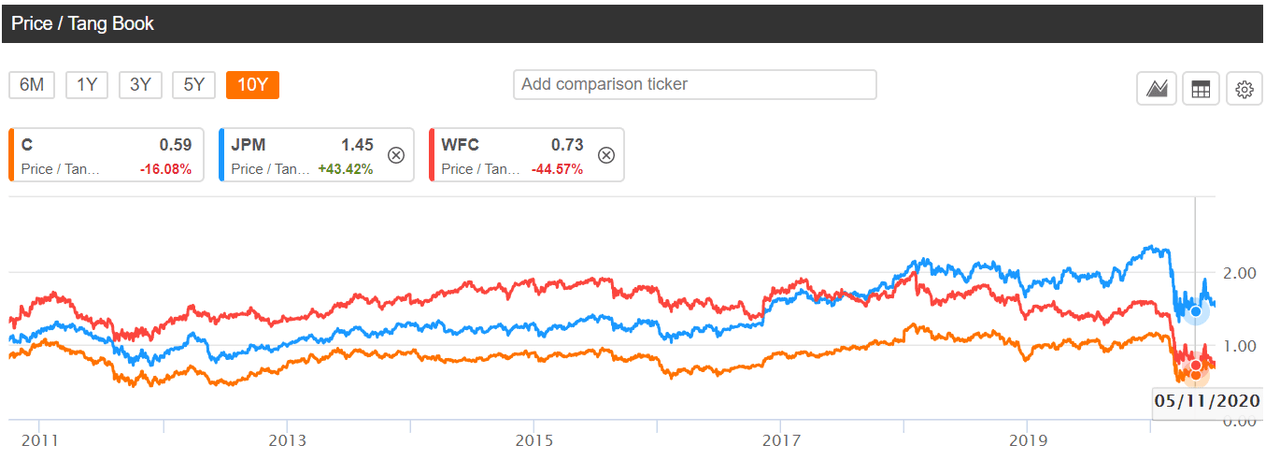
“The largest banks are dominating digital banking like never before,” he added.
- 07/07/2020 – Fees from PPP loans might help regional bank revenue
Banks Could Get $24 Billion in Fees From PPP Loans
JPMorgan, Bank of America, others have pledged to donate profits from small-business lending program
JPMorgan Chase & Co. and Bank of America Corp. are in line to split between $1.5 billion and $2.6 billion in fees for being the conduits of the government’s aid program for small businesses stricken by the coronavirus shutdown, according to an analysis of newly released data.
The nation’s two biggest banks by assets delivered more emergency loans than any other lenders that participated in the Paycheck Protection Program and the two are set to earn the biggest fees as well, according to a review of disclosures made Monday by the Treasury Department and Small Business Administration.
In total, the more than 4,000 lending institutions in the analysis are in line to split $14.3 billion to $24.6 billion in processing fees for PPP loans, according to Edwin Hu, at New York University School of Law’s Institute for Corporate Governance & Finance, and Colleen Honigsberg of Stanford Law School.
It is common for banks to be compensated for facilitating loans made under government programs. What sets PPP apart is its size: The high end of the range of PPP fees lenders can earn exceeds the total size of the SBA’s flagship lending program in the 12 months ended Sept. 30.
Banks have said they don’t expect sizable profits for the program. Getting their systems up-and-running quickly required diverting thousands of workers to help with applications and building new software to manage the process.
In addition to the program’s fees, banks are also set to earn 1% in interest on PPP loans they hold that aren’t forgiven, not much more than their cost of funds. The SBA guarantees the loans, protecting banks against defaults.
- 05/18/2020 – banking sector is way lagging SP500 because (1) possible weak profit; (2) buyback and dividend halt; (3) bad loans and solvency issues from destressed companies esp energy companies
Powell’s Comments Spark Bounce in Bank Stocks. But This Rally May Not Go Far.
Bank stocks have lagged behind the broader market as low interest rates — and the fear of negative interest rates — coupled with a weak economy is expected to pressure profits. But on Sunday, Powell, while acknowledging that the economy may take time to recover, again threw cold water on the notion of negative rates.
“The evidence on whether it helps is quite mixed,” Powell said in an interview with 60 Minutes. “It can also tend to depress the profitability of banks, which makes them likely to lend less, which weighs on economic growth. So I would just say it’s not at all settled in, you know, in economic analysis that negative rates really add much value.”
Bank stocks soared early Monday, with the KBW Nasdaq Bank Index (BKX) climbing 6.6%, outpacing gains in S&P 500, which was up 3.2%. Shares of JPMorgan (JPM) were up 4.6%, Citigroup (C), up 6.4%, Bank of America (BAC), up 5.2%, and Wells Fargo (WFC), up 6.9%.
Investors may have less fear about banks going under , but they know profits will be weak. Many banks have halted buybacks and some dividends may be under pressure . One needs to look no further than the performance of bank bonds compared with their stocks to witness this split sentiment on the sector.
Before Monday’s rally, bank stocks were down roughly 40% since February’s market high while the S&P 500 was down roughly 16%.
Unfortunately, history is not a reliable guide to when bank stocks will see outperformance during the recovery. KBW identified 12 market downturns since 1997, and found that in the three months following the S&P 500’s trough, bank stocks’ performance ranged from losing 11.5% to gaining as much as 52.8%.
“Our analysis suggests that the bank stocks should be near a bottom if solvency issues remain off the table. However, this is not to say that banks will necessarily be strong relative outperformers,” Cannon wrote.
- 08/14/2017 – Intro of FAS/FAZ
- The Direxion Daily Financial Bull 3x Shares ETF FAS is a leveraged exchange-traded fund (ETF). Introduction of FAS is here or FAS_Investopedia.
- FAS aims to provide investors with results, before any fees or expenses, that approximate 300% of the daily performance of the Russell 1000 Financial Services Index. The underlying index is a subset of the Russell 1000 Index and measures the performance of securities classified as part of the financial services sector of the U.S. large-cap equity market. Index equities have an average market capitalization of over $10 billion.
- The fund facts of FAS/FAZ are listed in this FAS_FAZ_Factsheet
- There are 2 years options of FAS/FAZ which I can trade (see following figures of Jan 19″ calls, strike prices $50, $40, $60, respectively).
- Due to the current historical low interest rate and the deregulation of financial industry, I think I can long on FAS Calls.
Jan18 2019 $50 call, min $5.2 max $11.00 Jan18 2019 $40 call, min $10.0 max $17.50
Jan18 2019 $40 call, min $10.0 max $17.50
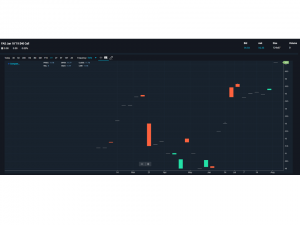 Jan18 2019 $60 call, min $2.5 max $6.00
Jan18 2019 $60 call, min $2.5 max $6.00
